What do Toruń Angels See?
Dedicated to Nicolaus Copernicus on His 550th Birthday
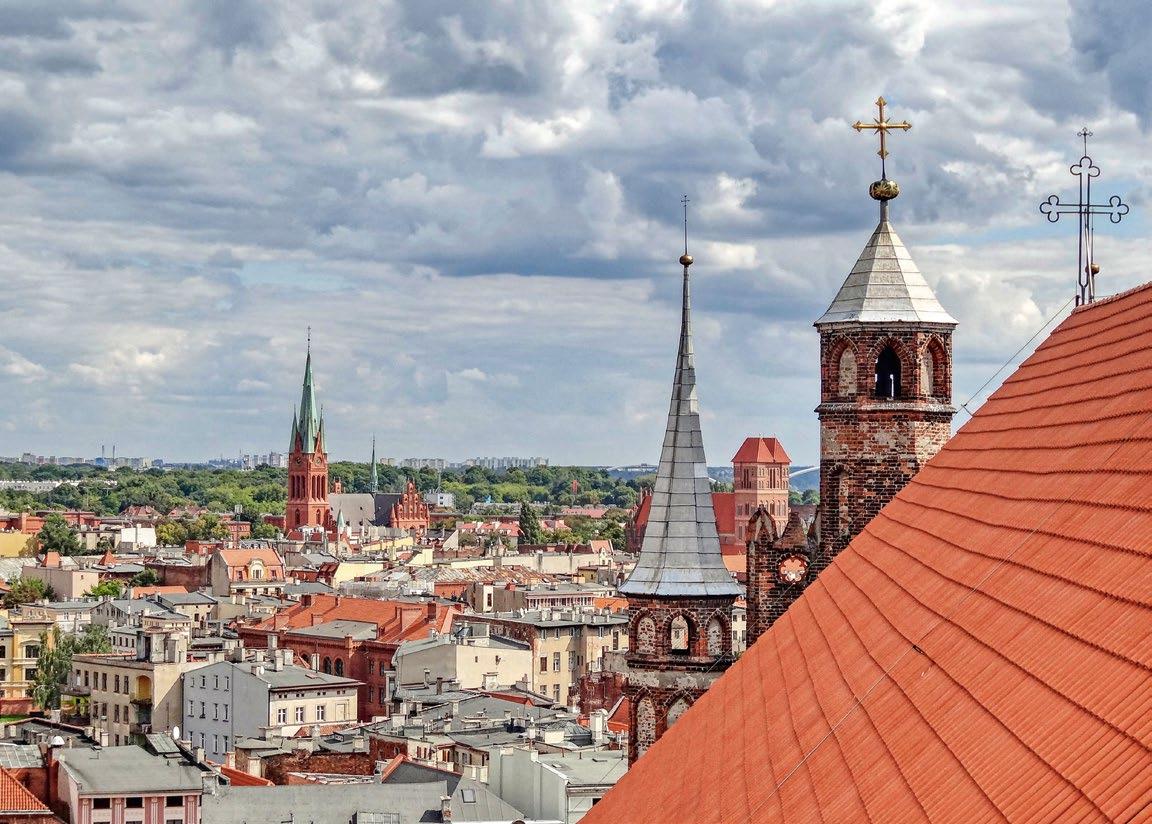 Lidia Smentek
Lidia Smentek

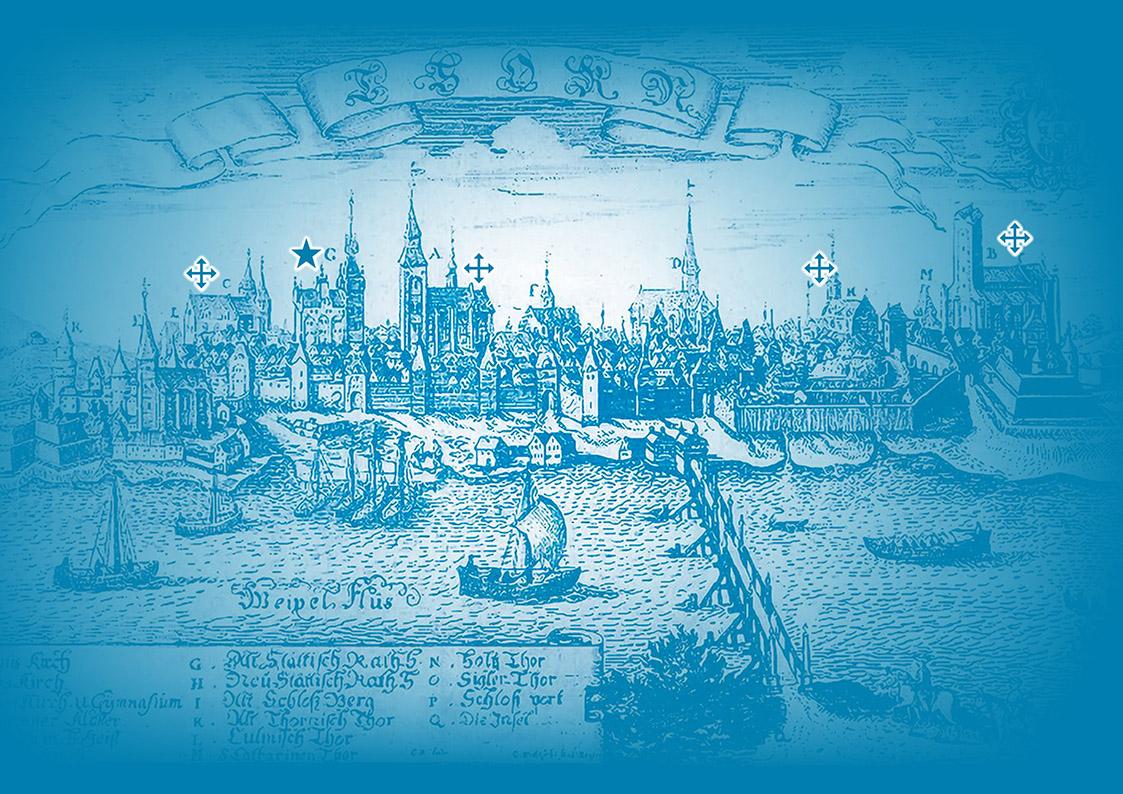
What do Toruń Angels See?
Dedicated to Nicolaus Copernicus on His 550th Birthday
What do Toruń Angels See?
Dedicated to Nicolaus Copernicus on His 550 th Birthday
Photographs from “the sky” – Włodzimierz Werner
Photographs from “the ground” – Andy Hess
Photographs of the stained glass – Sławomir Intek, Studio intek-art, Toruń

Photograph selection: Lidia Smentek, Andy Hess and Marcin Karasiński
Text and composition – Lidia Smentek
Language consultants: Andy Hess and Natalia Mielczarek
Layout and graphic design – Artepagina.com – Wojciech Prusakiewicz
Copyright © Lidia Smentek 2022
Toruń 2022
ISBN: 978 - 83 - 62826 -74 -2
Kujawsko-Pomorskie Region Subsidized from the budget of the Kujawsko-Pomorskie Region
Contents
Foreword 5
Piotr Całbecki, Marshal of the Kujawsko-Pomorskie Region
Preface 7
I. Toruń Angels 11
Family Album of Toruń Angels
Historical Glossary
II. Between Earth and Heaven; Between Ground and Sky 29

Church of St. Jacob the Apostle
Cathedral of St. Johns
St. Mary’s Church
Evangelical Church of St. Szczepan City Hall
III. Gothic to Touch 79
Dedication 93

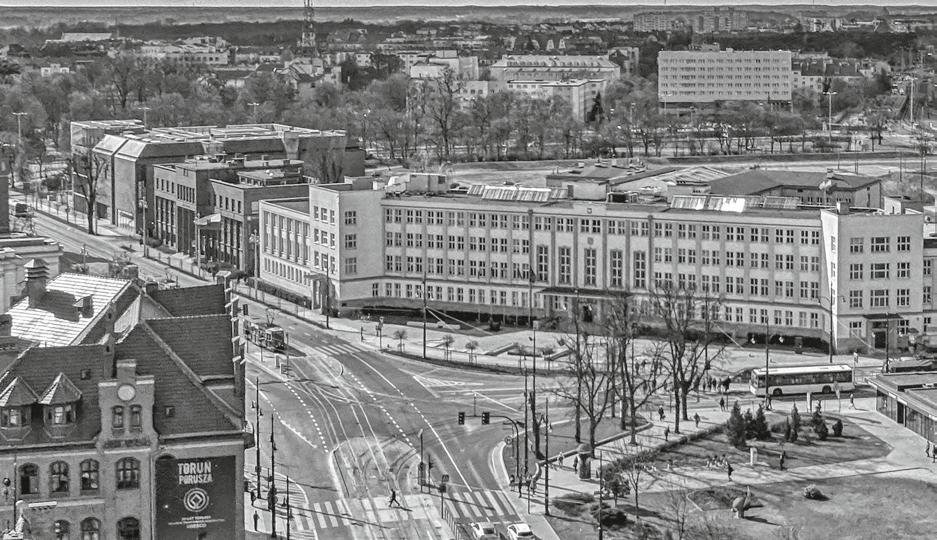
Foreword


All Christians believe that each human being has a protective spirit –a guardian angel. Interestingly, the ancients believed that not only humans, but also places and locations have their own spiritual guardians called genius loci.
Following eight centuries of Toruń’s existence, it is obvious that it is an extraordinary place that has played a significant role in Polish and world’s history. It is very important to remember that in Toruń, 550 years ago, Nicolaus Copernicus was born. He was a genius who changed the perception of the Universe.
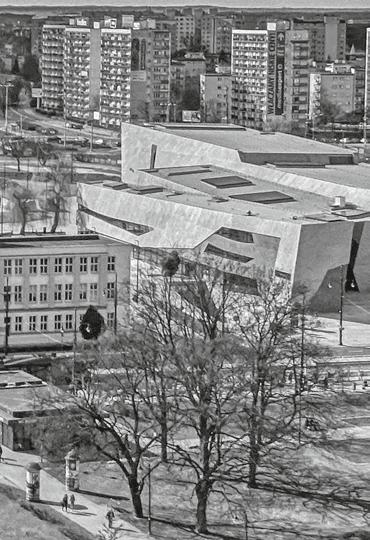
Copernicus, as a true man of the Renaissance, studied and practiced math, economy, administration, medicine, law, military strategy, cartography and philology. But as an astronomer and a man of God, he loved to contemplate the sky – the home of stars and angels. He believed that there is nothing “more beautiful than heaven, which of course contains all things of beauty.”
An angel is also an integral part of the Toruń’s coat of arms, and its story is irreversibly bonded to the story of the city itself. For the first time, the figure of an angel appeared in the coat of arms after the end of the Thirteen Years’ War (1454–1466). The angel guarded the city gate until the Second Partition of Poland in 1793.
The angel came back to the city coat of arms in 1920, when Toruń returned to an independent, reborn Poland. It disappeared in September of 1939. Neither Nazi Germans during the occupation of Poland nor the Polish government, after 1945 during the time of the so-called People’s Poland, tolerated any angels.
Since regaining the sovereignty and reintroduction of local governments in Poland in 1989, the spiritual protector was brought back to the coat of arms of Toruń. And now there are more and more images of angels decorating facades, windows and city walls of Toruń. These images are a visual proof that our city of angels is blessed with its own genius loci.
Piotr Całbecki Marshal of the Kujawsko-Pomorskie Region
5

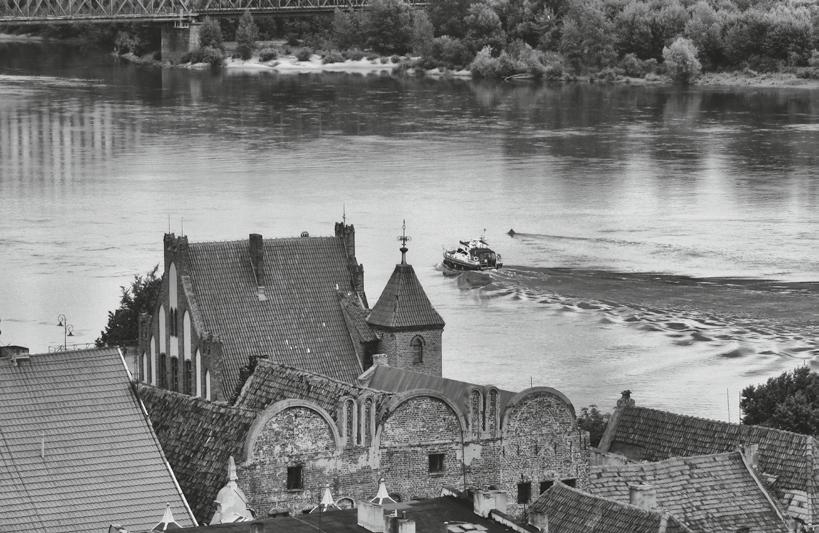
Preface
The centennial anniversary of the return of Toruń to the Motherland was celebrated on 18 January 2020. It was a great opportunity, and perhaps even a duty, to present the beauty of the city, although approached from a completely different perspective than usual. This is why the picturesque images, typically invisible from the street level, but observed for centuries from above by the Toruń Angels, were presented. It is not a mistake to use the plural of these celestial spectators, since not just one angel who is embracing in his protective arms a shield with the coat of arms of Toruń, but a whole family dwells in the city of Nicolaus Copernicus.
The English version of this presentation is especially addressed to all the guests who will join us, the local people of Toruń, to celebrate in 2023 the 550 th birthday of Nicolaus Copernicus, born here on 19 February 1473.
The album consists of two parts, which are directly linked to the title of the book.


The first part, preceding the presentation of the views observed by Toruń Angels circling over the city, is a short history of the Toruń coat of arms, dating back to the Teutonic Order and the Thirteen Years’ War (1454–1466). This story is presented on the background of modifications to the city seals that reflected political changes recorded in the history of the city and the whole district of Pomerania. To make it easier for the reader to connect historical facts presented here in an abbreviated form, the names distinguished in the text in blue are explained in the glossary following the numbers assigned to each historical event.
This first chapter also introduces the family of Toruń Angels that has settled in the city, a family that constantly expands as new artistic projects such as paintings and sculptures pop up around the city’s downtown area. In addition, houses of the local Angels are presented. Some of them are located high above the street level
– ideal vantage points for the Angels to observe the development of the city and follow the calm current of the Queen Wisła (Vistula), Poland’s largest river that connects Pomerania with Kuyavia.
The list of attractions advertised by tourist agencies inviting guests to visit Toruń usually contains Gothic, Copernicus and gingerbread. In fact, it should be supplemented by the Toruń Angels, since they have been taking care of the city and its inhabitants for many centuries and therefore deserve special attention, and most of all, respect and gratitude.
The photographs presented in the second part were selected from the archive of Włodzimierz Werner, an amateur photographer in love with his hometown. This is the main part of the book and shows Toruń as seen from five most significant points above the roofs of the Old and New Town. The buildings and streets were photographed from the observation deck of the town hall and towers or roofs of the churches: St. Mary’s, St. Jacob’s, St. Szczepan’s and the Cathedral; these are the photographs of Toruń as seen by its Angels!
Perhaps the easiest vantage point to reach for the photographer was the town hall tower as it is a popular tourist attraction that provides a panoramic view from 40 meters above street level. Tower renovations of the medieval churches made it possible for Werner to climb the scaffolding and show that the city of Copernicus is indeed situated on the Wisła (Vistula) ribbon, a fact that one is unaware of when walking down Szeroka Street (Brodaway), the main street in downtown. The opportunity to reach Toruń’s rooftops also allowed the photographer to show that there is a grain of truth in the legend that explains the origin of the name of the city.
This story goes that a long time ago, at the beginning of the settlement of the town, the Leaning Tower, which is a part of the city wall, and Wisła had a conversation. The tower complained that 7
the water in the river, being so close, was the reason that its construction was getting weak, its walls tilting away from the vertical and in danger of falling into ruin. Wisła, being sure that it is more important than the brick tower, replied in a arrogant way with an ominous wish: “To – ruń” which means “fine, go ahead, fall into pieces, fall… to ruin!” This is how the city at the Wisła bank got its name of Toruń. It should be pointed out however that the Leaning Tower, although still tilting, exists; and that Wisła did not change its riverbed after all.
The photographs presented in this album are selected from a collection of about three thousand different shots of various objects, the images taken over an 11-year span. They show the famous “Gothic to touch” pictured by decorative elements of medieval architecture that are inaccessible to the human eye from the position of an observer standing on the ground.
In order to enrich the visual experience while viewing the photographs “from the angels’ eye point of view,” a CD is attached with the “Anthem of Pomerania,” composed by Zygmunt Moczyński (a local composer and professor of music) for the tenth anniversary of Pomerania’s return to Motherland in 1930. The recording was made on 1 October 1988 by the local choir Copernicus under the direction of Professor Roman Grucza (technical realization by Kazimierz Wrzesiński). This choral performance is followed by a recording of music of the cathedral bell, Tuba Dei, the largest medieval bell in Poland, which, according to a legend, is also responsible for the angel present in the coat of arms of Toruń. The recording, professionally made by Mariusz Zaczkowski from the MTS Studio in Gdańsk, was made available, courtesy of Dr. Krzysztof Przegiętka, by Elżbieta Jakubowska, director of the Scientific Society of Organization and Management in Toruń.
The album was a modest contribution to the ceremonial celebration of the jubilee of Polish Toruń in 2020. As mentioned, the present version is prepared on the occasion of the 550 th birthday of Nicolaus Copernicus to be celebrated in 2023. Neither publication would have been created without the photographic passion

of Włodzimierz Werner (WW). Furthermore, the collection of his photographs would not have seen the light of day, if it were not for the generous gift of Marshal Piotr Całbecki, who, by the decision of the Regional Government of Kujawsko-Pomorskie, designated a fund to cover the cost of its publication.
My gratitude also extends to the following people, without whom this project would not have been possible:
– Professor Teresa Borawska,
– Dr. eng. architect Lucyna Czyżniewska,

Elżbieta Jakubowska, director TNOiK,
– Dr. Cezary Kardasz, director of the Scientific Society of Toruń,
– Dr. Krzysztof Przegiętka, bell ringer of Tuba Dei,
– Dr. Henryk Rietz,
– Agnieszka Wiśniewska from the Digitalization Office of the Nicolaus Copernicus University Library in Toruń.
–
Lidia Smentek March 2022
8
Stained Glass Studio intek-art in Toruń
Toruń Angels


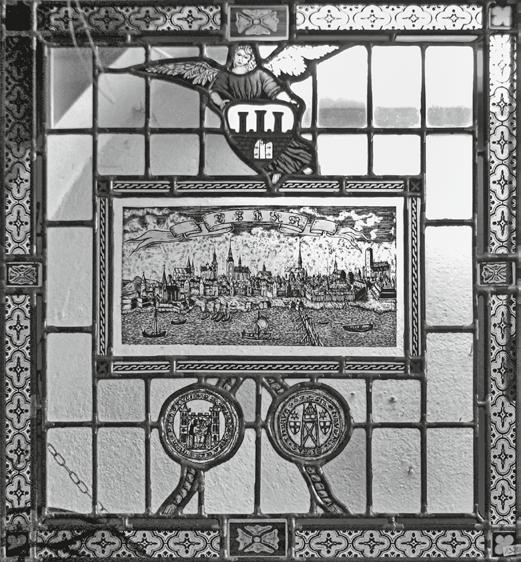
I. Toruń Angels
Where do the angels live? Every child knows that in heaven. However, the answer to the question where is heaven is not so straightforward. It only seems to be obvious that heaven is “up in the sky,” and even it is a simple task to show it with an arm risen above the head. This direction is also supported by the icons or altars in Catholic churches if, for example, the direction to heaven is clearly pictured by the icon of Assumption of Virgin Mary.
If the Earth were flat, in contradiction to Copernicus’ order of the Universe, this direction would indeed be correct. However, within this childish picture of the world hell would be below, down under. But the Earth is a globe, and “down there” is Australia with its own heaven above in the sky! Thus, the simplest solution on this problem is to separate heaven from the sky and place the celestial objects in the paradise but without trying to find the way how to get there.
In any case, for centuries it is well known that angels also live in Toruń! Not just only one who is present in the city coat of arms, the Guardian Angel, but a whole family of them. They found a nice, friendly and warm place here in Copernicus’ hometown [1].
When did for the first time an angel appear at the Wisła (Vistula) bank? In order to find the answer to this question it is important to learn more about roots of the Toruń coat of arms and its historical fate.

The city coat of arms, the symbolic emblem of any city, in general is influenced by all historical changes and political conditions of a given territory, especially in case of loss of its independence. This was the fate of Poland for centuries. The historical past of Toruń is divided into several periods dependent on its political administration that was changing over the years, or even centuries; not by choice but by political decisions made by the so-called powers, which formerly governed all of Europe.
At the beginning there was the Teutonic period, since the Knights of the Teutonic Order [2] were the founders of town. This was the Catholic Order (in fact still existing), sometimes called the Or der of the Crossbearers because of their characteristic white mantle with a huge black cross visible even from a distance.


In 1454 the Old Town, with the municipal rights written in 1233, was unified with the New Town, established in 1264 and settled just behind the city walls. Since then, Toruń has become a prosperous town under one administration, but still with a deci sive Teutonic influence. But not for long. This was the beginning of the history of symbolic seals and coat of arms of Toruń; and also the time of growing conflicts with the Knights of the Order.
To make the chronological review short at this point of presen tation, one has to skip over several centuries to avoid the details of many turbulent battles and other dramatic historical events. To show just the most dramatic turns in the past of Poland, a forward jump in time reaches the second part of XVIII century. This was the beginning of political changes with tremendous impact upon the whole country, and in particular on Pomerania and Toruń. There were three consecutive partitions of the Polish-Lithuanian Commonwealth between foreign invaders: the Russian Empire, Kingdom of Prussia and Habsburg Empire (Austro-Hungarian Empire since 1867). In every book of Polish history there are three important entries: 1772, 1793 and finally 1795 when the country disappeared completely from the map of Europe for 123 years. This was the year when the King Stanisław August Poniatowski, escorted by Russian soldiers, left Warsaw and abdicated. The country was divided: 82% of the territory of the country that was left after the First Partition in 1772, including Warsaw, became Russian; 11% belonged to Austria and 7% to Prussia. However, it was not only a division of the country
11
in a geographic sense, but in fact it was an annexation of the territory, and each of these parts became the parts of imperial Russia, Prussia and Austria, with boarders between them.
These partitions of the whole country resulted in the Prussian period of Toruń and the district of Pomerania. There was only a short period during which the city was under the rule of the Duchy of Warsaw, proclaimed by Napoleon in 1807. But it did not last long enough to leave a lasting impact on the city and symbolism of its coat of arms.
Another jump in history marks the date of 18 January 1920. This date is noted in large font in all calendars, since as a result of the Versailles Treaty [3], the independence of the country was proclaimed and Pomerania, together with Toruń, returned to the Motherland. This is the historical event that was celebrated in 2020 and in fact the Polish version of the album with pictures of Toruń seen by its Angels was dedicated to this centennial jubilee.
On 1 September 1939 the Second World War was proclaimed. The country was destroyed and German occupation started. During this time it was impossible even to show nationality or any other sign of Polish roots, and death was the punishment for speaking in Polish. Liberation from German occupation came in 1945. It was followed by years of People’s Poland, and within the ideology of this new political system there was no place for angels; simply they did not exist even as symbols. Finally, political changes of the system in 1989 rebuilt completely the nationality and spirit of Poland. Since then, not only one angel returned as the Guardian Angel to the symbolism of the historical seal or coat of arms of Toruń, but his whole family legally appeared again in various places in town.
These few data subtracted from the history of Poland are the orientation points for the story about the roots and modifications of seals and coat of arms. The symbols had to adjust to locally existing situations and to change over the centuries; to reach finally the style and message as represented by the Toruń Angel of modern coat of arms.
The story is rather rich in changes, modifications and turbulences, and it began in the 13 th century.

A banner of a legion of warriors very often serves as an archetype of the coat of arms for a given city. However the strongest impact on shape and symbolic message of any logo originated from the seals used for authorization of historical documents to give them legal authority. In the case of Toruń, the details, history and interpretation of the symbolism of coat of arms and also the city seals are presented in the book by Karola Ciesielska “Herb i pieczęcie miasta Torunia” (Toruńskie Towarzystwo Kultury, Biblioteczka Toruńska Nr 3 – Toruń 1982). The contents of this very book define the canvas of the story below.
The oldest seal was found on the document signed on 15 March 1262 by the City Council of Toruń and the Knights of the Teutonic Order. It was a large round seal, rather magnificent, with two towers connected by an arch under which there was Virgin Mary with Baby Jesus. This was the so-called Maria’s seal (pieczęć Maryjna). It is speculated that this particular seal was dedicated to the city by the Teutonic Order to emphasize clearly that the town was founded by them. This interpretation is rather reasonable because Virgin Mary was their patron. The Maria’s seal was used for many very important documents. For example, in 1411 it confirmed the Peace Treaty of Toruń signed between the Polish Kingdom and the Teutonic Order, the agreement concluding the battle of Grunwald in 1410 [4]. The importance of this seal was evident up to the end of 18 th century, however it was not used very often.
In 1339 a new seal appeared on the state documents. It pictured St. John, the patron of Toruń standing between two trees, and this is why it was called the St. John’s seal (Świętojańska pieczęć). The importance of this seal is proved by its imprint on at least two historical documents. With this seal, The City Council of Toruń certified on 28 May 1454 the tribute and surrender to the Crown of the Polish Kingdom, King Kazimierz Jagiellończyk. It was also used on 19 October 1466 to authorize the Second Peace Treaty of Toruń, which finalized the Thirteen Years’ War [5].
12
In addition to the important seals, which authorized the documents to give them legal force (as those above), the City Council in everyday activity was using other seals, just to seal the letters or other less important documents. It is interesting that these rather small and at first glance irrelevant seals with time became the main origin of the coats of arms of towns and their symbolic emblems. Various versions of the Toruń coat of arms appeared during the 14 th century. This period is regarded by historians as a time of the most rapid creation of different symbolic identifications of the town. Although there were different versions of artistic combinations of symbols, one element was always present, and it was a city wall with three towers and an open gate in the middle. Is it possible that this arrangement was inspired by the seal of the Grand Master of Teutonic Knights, since it indeed presented a castle tower with a gate?
In 1410 in the battle of Grunwald between Kingdom of Poland (King Władysław Jagiełło) and the Teutonic Order, the Knights from Toruń fought under the standard with a picture of a city wall with three towers, the middle one higher than the other two, and an open gate in the middle.
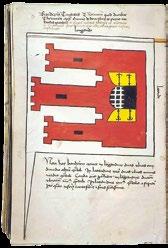


Jan Długosz, the first Polish historian and creator of the Polish heraldry published in 1448 “Banderia Prutenorum” with an outstanding collection of 56 Teutonic banners. Among them, 51 were military trophies from the Grunwald battle won by the Polish warriors. One of this collection was a banner that belonged to the Knights from Toruń, since they obviously were fighting against the Polish king! All these historical symbols were included as illustrations in a book by Długosz, and therefore it was possible to restore the history of the city coat of arms. This is why it is known now that the picture on the Toruń banner from Grunwald, with the medieval version of the emblem, became the origin of all the symbols created later. Namely, three red towers, the middle one higher than the other two, each tower with one black window, below in the middle a golden double gate with doors opened out to the sides, and the opening partially covered at the top by a suspended silver grille. The fate of this historical collection of standards kept in Wawel, the royal castle in Kraków, was as complex as the history of Poland, and only thanks to this book from the 15 th century it was possible to reconstruct all the prototypes of the city coats of arms.
The letters preserved in the archives, which are dated from the period of 1405–1507, contain the imprint of a small “signet” seal with the symbols arranged for the first time in a heraldic form. The three towers with an open gate are placed on a shield. This particular arrangement survived centuries.
As mentioned, in 1454 there was unification of the Old Town with the New Town, a separate settlement with its own City Council and court, and obviously also with customized seals and coat of arms. The oldest preserved seal of the New Town is from 1338. It contains the Teutonic shield to confirm symbolically the dependence of town on the Order, especially because the Grand Master (in fact on a local level called komtur) was even a member of the local council.
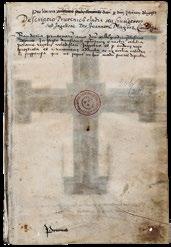
13
The title page of book by Jan Długosz from 1448, in the middle of the cross there is a seal with three crowns and description of Archives of Kraków Diocese; the next illustration presents the banner with the Toruń coat of arms from the Grunwald battle (Jagiellonian University Library; public domain)
The coat of arms of unified Toruń however was taken from the style of the Old Town symbolism with three towers and an open gate. After unification of both parts of town, even the coins were issued in the city mint with these symbols to manifest in this way the change of the political situation after gaining a slight independence from the Knights.
In general, the year of 1454 was a special year in the history of this region of Poland. The political situation was changing rapidly. On February 4 th war was proclaimed against the Teutonic Order, as announced by the local representatives directly to the Grand Master in Malbork, a town with the main castle of the Order. On February 6 th the nobility together with the residents of Toruń rose up against the Knights and attacked their castle at the Wisła bank. The leader of the Prussian Confederation [6], Jan Bażyński, inspired by events in Toruń, asked King Kazimierz Jagiellończyk to incorporate Prussia into the Royal Kingdom of Poland as a fiefdom. As a reply, on March 6 th the King issued the incorporation document that meant the proclamation of war against the Order. This was the beginning of the Thirteen Years’ War concluded in 1466 by The Second Peace Treaty of Toruń. This very important document was legally authorized by the St. John’s seal. During this turbulent time in history the City Council preferred to use the St. John’s seal over Maria’s one just to avoid even a slim connection with the Teutonic Order, since as mentioned before, the latter seal was possibly associated with the Knights.
On 28 January 1470 (three years before Nicolaus Copernicus was born) the first Toruń Angel appeared on an imprint of a big seal that had been pressed by City Council on a document addressed to the Council of Gdańsk! Indeed, for the first time in history there was an ANGEL on the coat of arms of Toruń, standing with arms embracing the shield with the known symbol of three towers and an open gate in the middle. Thus, since 1470 an Angel is present in Toruń and finally he found a place on the coat of arms. Only in 1488 his position was changed from standing to kneeling but still with arms embracing the shield, with head

bent down showing his concerns about the town and also promising a cordial care of its residents.
This seal was used for almost 300 years, and its imprint is preserved on many documents and letters kept in the archives. This symbolism became the archetype for Toruń’s coat of arms until the 1930s.
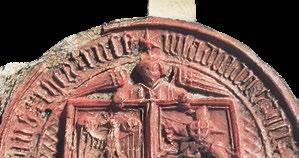
Why did an angel appear in the Toruń coat of arms? There are many answers to this question and even there are some legends circulating, however there is no evidence of the reason or origin of this particular enrichment of the previous symbolism. The author of the book cited above, Karola Ciesielska, suggests that the main inspiration possibly originated from the angels of the magnificent seal of King Władysław Jagiełło, who won the battle at Grunwald. It is also possible that the Guardian Angel taking care of Toruń is the artistic form of gratitude of residents for God’s help during the Thirteen Years’ War against the Teutonic Order.

14
An angel holding the shield on the seal of Władysław Jagiełło, the Grand Duke of Lithuania and King of Poland, 1386 (Public domain, Wikimedia Commons)
Copies of the historical seals from the book “Sztuka w Toruniu: Zarys dziejów,” ed. Emanuel Okoń (published by: Wyd. Muzeum Okręgowe i Towarzystwo Naukowe, Toruń 2014); below a copy of the First Toruń Treaty with denoted Maria’s seal (from the Archives: Archiwum Główne Akt Dawnych)









 Three towers and an open gate, the origin of Toruń symbolism; a common seal for the Old and New Towns since 1454
The St. John’s seal (pieczęć Świętojańska),
Three towers, open gate and an angel, a seal used from 28 January 1470
Three towers and an open gate, the origin of Toruń symbolism; a common seal for the Old and New Towns since 1454
The St. John’s seal (pieczęć Świętojańska),
Three towers, open gate and an angel, a seal used from 28 January 1470
15
Coat of arms from 1601–1609 on organ prospectus in Saint Mary’s Church in Toruń (Piotr Kożurno, https://pl.wikipedia. org/wiki/Herb_Torunia#/ media/File:Torun kosciol_NMP_ organy_herb_Torunia.jpg)
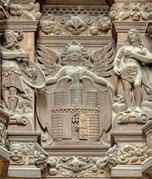
The tourist guides in Toruń tell a legend to the visitors to the Old Town. It was predicted centuries ago, during the Medieval time, that in 1500 there would be the end of the world as a punishment for sins and all of people’s faults. Out of fear the residents of Toruń decided to appease God, and they funded the magnificent bell, Tuba Dei (God’s Trumpet), that was installed in the newly built tower (around 1480) of Saint Johns’ Church. On 22 September 1500 Toruń heard for the first time the music of the oldest Gothic bell in Poland, cast in Toruń in the foundry of Marcin Schmidt, as it is now known. The size of this bell is still impressive – the weight is seven tons and its diameter is 2.27 meters. Its beautiful music was the reason that God, as an answer for this gesture, sent an angel to protect the city against misfortunes, plagues and wars. Perhaps God’s decision and the presence of the sent angel indeed protected the town from destruction during the Swedish invasion [7]. It is also possible that the Toruń Angel defended the town during the Second World War, and due to his protection we are still able to enjoy the authentic Gothic monuments and the atmosphere of the original Old Town.
In every legend always there is a small grain of truth. In this one the dates are correct and also that the Toruń Angel is still present in town; in fact there is a family of Toruń Angels as presented below. To summarize, the first angel appeared on an imprint of a seal in 1470, in 1488 he changed his position, and the City Council introduced the seal with this modification in 1507. This means that it happened seven years after the expected end of the world, and seven years since Tuba Dei began its historical role.
The protective and caring angel leaning over the shield with Toruń coat of arms is still a symbol. Its presence was perceived with pride from the very beginning, and this sentiment continues to this day.
From the end of 16 th century this special symbolism inspired poets and numerous poems devoted to the coat of
arms of Toruń were written. The best example of a hymn of praise is the poetry of Ulryk Schober (1559–1598). He was a philosopher from Leipzig, who as a master of Latin language and expert in Greek, as a 25 year old young man was appointed to the post of vice-rector of the famous Toruń Gymnasium [8]. He deserved a special recognition due to his decisions and activity for development of the Gymnasium. Indeed, thanks to him a rich collection of the school library was established, mainly because of his strong support for free access to the literature, not only theological, but also to scientific books. As a consequence, in 1594 the Gymnasium was promoted to the level of an academic school, known also abroad for its library and scientific education.
Bronisław Nadolski in his book “Ze studiów nad życiem literackim i kulturą umysłową na Pomorzu w XVI i XVII wieku” (Zakład Narodowy im. Ossolińskich, Wydawnictwo PAN, 1969) gave the best description of Schober’s role as a poet, when writing, “Taken as a whole, Schober presented himself in Toruń with a collection of his Poems as a thorough Renaissance poet, the first writer in this area to write so much about the people of this city.”
In particular, one of the poems by Schober is dedicated directly to the Toruń coat of arms. Through its translation from Latin to Polish, and then to English, possibly its poetic beauty is distorted, but indeed it describes in detail the symbolic composition of the city wall, an open gate and obviously an angel. It is interesting that the interpretation of an open gate present on the shield that is given in this poem is still a credo for many proud Toruń residents. Namely, since the gate is only half-open, it is explained that this open part shows the access to town for all what is good. Thus the town is open for all the guests, while the other part of the gate is closed for all what is evil, and therefore is closed for all enemies. In another poem Schober added that the three towers on the shield are also symbolic because they represent three major powers in the city: justice (court), religion (church) and family (house), as explained by Marian Gumowski (in the book “Pieczęcie i herby miast pomorskich,” Tow. Nauk. w Toruniu, 1939).

16
The artistic composition of the front page of the collection of Schober’s poems “Olbiopolis seu civitas beata,” published in 1592, serves as a clear evidence of the special dedication of the author to Toruń and his admiration of its symbolism. On this page there is an imprint of a signet seal produced in Leipzig. It is very similar to one from the 17 th century owned by the printing house of Franciszek Schnellboltz in Toruń, and used in 1635 on a panegyric published in honor of King Władysław IV.
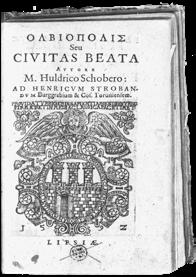


When comparing both versions of these used seals, it becomes obvious that the earlier one was the template for the later. This conclusion is supported also by a fact that the owner of the printing house in Toruń was originally from Leipzig.
The 18 th century brought changes to the political situation in the country, and as a consequence, also to the rules of symbolic composition and presentation of banners, coat of arms and official seals. The May 3rd 1791 Constitution [9] was proclaimed and the Republic of Poland was established with the threefold separation of powers. This was a period with new a administration, new structure, and new ministries. All these modifications of the country were the reason that many new symbolic signs and seals were introduced. It led also to the change in the Toruń coat of arms, but only a slight one. The angel taking care of three towers with an open gate remained in place, however the shield disappeared from the emblem, as Gumowski described in the book cited above.
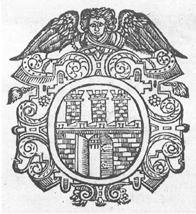
In 1793 there was a Second Partition of Poland. Ciesielska clearly stated in her book that under Prussian rule Toruń lost its independence and all previous privileges. The main aim of a newly established administration was to include the town under a strong system of Prussian rule and to forget all that would prove or demonstrate the Polish roots, history, culture, tradition and simply, style of life. After more than 300 years of presence, the Toruń Angel disappeared from the coat of arms and was replaced by Prussian black eagle. Ciesielska pointed out that “the banner lost its Polish character,” and “the new details of heraldic art were rather strange since never before in Polish style was there a round shield.” Obviously, the Polish inscriptions on historical seals had to be adjusted to new political requirements and were also replaced by a German version.
The front page of the collection of poems by Ulryk Schober, published in 1592 (Antique Collection of Library in Elbląg, Pol.6.II.86); imprint of signet seal from the printing house in Toruń of Franciszek Schnellboltz from 1635 (Library UMK Pol.7.III.285 adl.)
The Angel returned to the emblem when Toruń was under the rule of the Duchy of Warsaw [10] established in 1807. He was taking care of the towers with the gate still keeping the same posture, but without a shield. On the seals again the Polish versions of inscriptions returned, however only for a short time. On 28 April 1811, due to the order issued by the rulers of the Duchy, all the heraldic seals were replaced
17
by a new version with the state emblem rather than with local symbols. The Vienna Congress of 1815 [11] changed everything! Again. Toruń was once again under Prussian power. Therefore the Prussian eagle was present in the coat of arms. In the case of city seal – now the eagle was sitting on the middle tower of the historical stylization!
Example of a seal with three towers, open gate and Prussian eagle sitting on the middle one. This is the imprint of a seal on the front page of Samuel Thomas Sommerring’s book (born in Toruń in 1755) who identified 12 pairs of cranial nerves. This seal documents that the book belongs to the library of Royal Toruń Gymnasium (Soemmerring was its graduate)
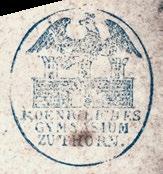
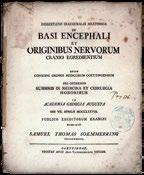

The title page of the Toruń calendar for 1761 (from the collection of the Copernicus City Library in Toruń) also certifies the changes in the symbolism of the city during this special time in its history. The ownership of this calendar is in Latin and all the other inscriptions are in German; this calendar belonged to the Library of Toruń Gymnasium. In the center of this page there is an emblem in its medieval, original version, in which an angel is standing and with both hands holding the shield, protecting the three towers with an open gate. These symbols have not been changed. However, in the upper right corner of this page there is a slightly hazy seal with the Prussian eagle sitting on the middle tower, replacing the traditional angel! This seal was adapted to the political atmosphere prevailing in Toruń at that particular time, although the original symbol, printed in the middle of the page, survived.

Toruń calendar for the year of 1761; in possession of the Library of Toruń Gymnasium (from the collection of Copernicus City Library in Toruń)
In the mid-nineteenth century the angel returned to his place, although there were many versions of his position in relation to the heraldic shield. And then, at the end of this century there was a characteristic change introduced to the emblem. It brought back the traditional and historical symbolism from 1488! The angel again was kneeling at the shield, and in addition he held in his right hand a large symbolic key to the gate of town.
In 1916 a special order for new city seals was sent to the then contemporary famous artist Otto Oertek in Berlin. This was also a symbolic return to the original and historical seal used from the end of 14 th and during the 15 th centuries. It is interesting that in the same artistic atelier in Berlin a medal was cast to celebrate 350 th anniversary of the founding of the Toruń Gymnasium. This jubilee was celebrated on 8 March 1918, still under the rule of Prussians, but only a few months before the truce with Germany that happened the same year on November 11th (end of the First World War).
18
The reverse of this medal presented an image of the hard work of all residents, including the students of gymnasium, determined to support the power and perseverance of Germany during the lasting war. On the other side of this medal, on its obverse, there was a building of the school (modern, from 1855, and still existing), and above its roof, up in the sky, there was a protective angel holding the traditional heraldic shield of Toruń. Historically it was the time very close to the change of the political situation. Thus, the presence of this symbolism on the medal had a special meaning for native Polish citizens, especially because during the Prussian control to show Polish roots or any association with them, was forbidden by the invaders.

The delay of realization of the Versailles Treaty signed after the First World War, was caused by some political and technical difficulties with the local German authorities. This is why the Polish Army, under the General Józef Haller, finally arrived in Toruń on 18 January 1920 to liberate this district of Poland after years of Prussian rule. In 2020 there was a special celebration in Toruń, since on that very day one hundred years ago it became the capital city of Pomerania, a part of Poland again.
Toruń was back in the Motherland; and the Toruń Angel was also back in his historical place on the coat of arms; however –again not for a long time. This is our history!
Dr. Otto Steinborn, the commissary mayor of Toruń, just after the liberation, took care of new symbolism by adjusting it to the political changes, however a dilemma arose: which of the historical banners should be selected. In July of that year, a new seal similar to the one ordered in 1916 in studio in Berlin was ready with the inscriptions obviously in Polish.


Finally, on 2 July 1936, the official seal and Toruń coat of arms were approved by the Ministry of Internal Policy. In the published document all the details of the symbolism were precisely described and defined, including the structure of the towers and even the colors of angel’s robe:
The document stated: on the silver background there are city walls in red with three towers of the same height. In the side towers there are single windows, black in the opening. In the wall there is a double gate with golden doors, but silver frames, one half-open with a silver harrow hanging in the middle. The opening of the gate is black. The heraldic shield is held by a kneeling angel dressed in a light blue robe and with silver wings. The hair of angels is black, and face and arms are of natural color.
Obverse of the medal celebrating the 350 th anniversary of the Toruń Gymnasium (from the collection at school)
The current coat of arms of Toruń (presented here by permission of the President of Toruń, Michal Zaleski) 19
And then, on 1 September 1939, Poland was attacked by Hitler’s Army; this was the beginning of Second World War and a very dark period of Polish history under German occupation. The Toruń Angel had to disappear as all the other national symbols!
There was no place for an angel in the Toruń coat of arms also after liberation in 1945 and during the time of leading ideology of the People’s Republic of Poland. Officially Toruń Angel was back after political changes in 1989. The design of the coat of arms was almost identical as that one established in 1920. There was one difference: similarly as at the end of the 19 th century, the Toruń Angel has been holding in his right hand a symbolic golden key to town, as being responsible for its peace and prosperity. The Toruń coat of arms decorates the facade of the City Office. However, above the main entrance to the building, on the artistic stained glass there is a new version of the heraldic shield. In this presentation the historical angel was secularized, and he is pictured without wings, the main attribute of the celestial object. There is a cornucopia built in, as if instead, and this particular element might suggest that this symbolism came from before political changes in 1989; from the time of material and ideological prosperity, as the former political rulers in Poland were proclaiming to the nation. During hundreds of years, since the Thirteen Years’ War, when the angel had been continuously guarding town – the family of Toruń Angels is significantly enlarged. Does it mean that there is Los Angeles at the Wisła (Vistula) bank?
In any case, the same question appears now, as at the beginning of this story, where are all these Toruń Angels living? Those material, artistic, traditional and modern, all are obviously living above the level of the ground, sometimes quite high above the streets, but still they are visible if you know where to look for them. Those
celestial and fleeting are living much higher and although they are invisible, their guardian care is still perceptible; as for many past centuries.


In fact, the family of Toruń angels has to be completed. It is known that Nicolaus Copernicus plays a role of a symbol for the town, but there is another symbol – this is gingerbread! Famous Toruń gingerbread. The tradition of baking these special cookies goes back to the 15 th century. Thanks to the royal privilege from 1557 Toruń bakers were granted special rights to sell their gingerbread at royal markets. The tradition was booming during the 17 th and 18 th centuries, and it lasts until now. In the local museum there is a rich collection of wooden forms that were used centuries ago, and one of them of course pictures an engraved angel; Toruń angel in gingerbread. The modern composition of the form includes also the coat of arms, and therefore it presents in this unusual way the history of town.
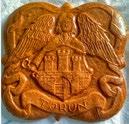


20
Historical wooden forms for baking the famous gingerbread of Toruń (photograph by Krzysztof Dreczyński, Photographic Studio of the District Museum in Toruń)
Family album of Toruń Angels
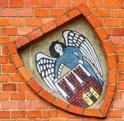

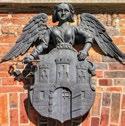





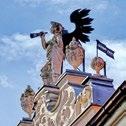

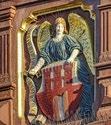
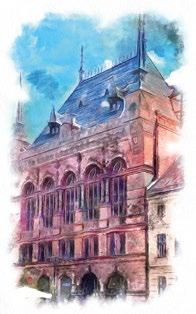

 Dwór Artusa
Dwór Artusa
Katarzyny 4
Ratusz
Szeroka 27
Łuk Cezara
Straż Pożarna
21


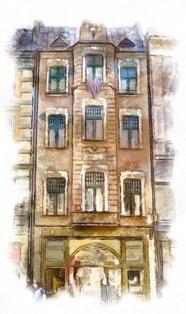
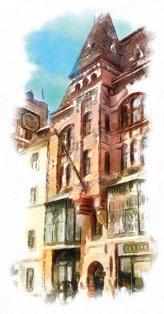
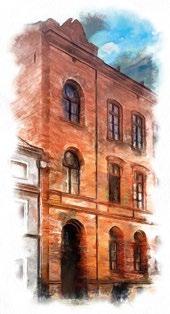
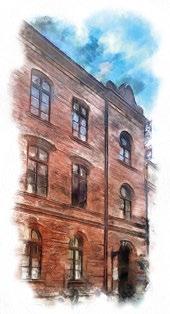

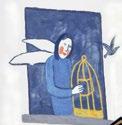


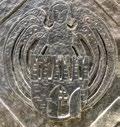



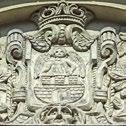
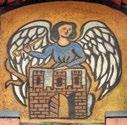 Stary Rynek 1
Stary Rynek 1
46
Szeroka
Szeroka 31
Ślusarska 4
Wielkie Garbary 9
22
Szczytna 2 / Szeroka 26–28
Historical glossary


[1] Nicolaus Copernicus: Catholic canon, polyglot, talented in mathematics and astronomy, also physician, translator, diplomat and economist. A versatile scholar and author of the heliocentric order of the Universe was born in Toruń on February 19, 1473; therefore it is common to describe Toruń as Copernicus’ Town.

as invited guests. They created an independent Monastic State of the Teutonic Knights and continued their conquest to increase the area of their influence by grabbing the Prussian land and terrorizing its native citizens. A deep conflict, which had arisen between the local residents and the Knights, lasted more than two centuries until the Second Toruń Peace in 1466.
The Order built in Toruń its first castle in Chełmno Land; the construction started in the 13 th century and lasted almost one hundred years. The castle was situated in a strategic place, along the bank of Wisła (Vistula) river but was demolished during the city’s rebellion at the beginning of the Thirteen Years’ War against the Teutonic Knights.

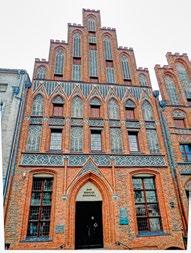
[2] The Order of Brothers of the German House of Saint Mary in Jerusalem, commonly known as Teutonic Order, was founded about 1190 as a crusading military order to protect Christian pilgrims on their way to the Holy Land and to organize hospitals for the sick and injured. In 1226, Conrad I, the Duke of Masovia (Mazowsze), invited the Knights to help him defend his territory against the pagan Prussians and most of all, to introduce them to Christianity. The Knights were allowed to use the Chełmno Land to fulfill this mission. However, they quickly forgot about the reason for their presence and started to violate rights and privileges given to them
[3] Versailles Treaty was the peace treaty that ended the First World War between the defeated German Empire and the Allied Countries. The formal agreement to a cease fire was signed on 11 November 1918, but the detailed negotiations took some months until 28 June 1919, when the treaty was signed and then registered on 21 October 1919. The document of ratification was deposited on 10 January 1920, marking a new political order in Europe. Poland regained a large part of the territory taken by Prussia
Nicolaus Copernicus with the lily of the valley, a medieval symbol of medicine (wood engraving by an unknown artist, edited by Sabinus Kauffmann, Wittenberg, ca. 1600); House of Nicolaus Copernicus, now his museum (photo WW)
23
Ruins of the Teutonic Knights’ castle in Toruń; the sewage tower (dansker) above the stream which joins Wisła (Vistula) river seen behind (photo WW)
as a result of the First and Second Partitions of the country with little access to the Baltic Sea and the port in Gdańsk, which became a Free City. On 21 January 1920 General Józef Haller, commander of the Polish Army, entered Toruń in triumph to take back Pomerania from the German administration; Toruń returned to the Motherland and became the capital city of Pomerania.
[4] Battle of Grunwald , on 15 July 1410 was the largest battle in medieval Europe, and perhaps the most important. The victory over the Teutonic Order under the command of King Władysław Jagiełło of combined forces of the Crown of Poland and the Grand Duchy of Lithuania made the union of these two nations the dominant political and military force in Europe. The battle ended with a Peace Treaty signed in Toruń in 1411 between the Teutonic Order and the Kingdom of Poland. Till this day, the battle of Grunwald remains a source of national pride for Poles, who remember it as a symbol of victory over foreign invaders.

[5] Thirteen Years’ War against the terror of the Teutonic Order started in 1454 with an uprising of the Prussian cities and was supported by the King of the Polish Kingdom. It concluded with the Second Peace of Toruń in 1466. From that time, the reclaimed Prussian territory was called Royal Prussia and remained initially autonomous, including its own coin minted in the royal mint in Toruń, but administered by a council, however, subordinate to the Polish King.

[6] Prussian Confederation, organized in 1440 in Kwidzyn, was a group of nobility and representatives of local clergy from 19 Prussian cities – with the main contributing forces from the Chełmno Land including Old Town Toruń, New Town Toruń, Chełmno, Elbląg and Gdańsk – determined to defend their privileges and rights. Initially, there was no intention to act against the rules and authority of the Teutonic Knights in Prussia. However, after 1435 when the liberties of the nobility became threatened by the Order, the conflict between Prussians and the Knights grew more and more acute. Toruń became the seat of the Secret Council of Confederation in 1453. It took only one year to start an open war with the Knights. Indeed, the Thirteen Years’ War was declared in 1454.
[7] Swedish invasion and occupation of Toruń started in 1655 and lasted for three years; it was the so-called Swedish “Deluge.” The main aim of the Swedish King Charles X Gustaw in invading Royal Prussia with Toruń (being the crucial target of the attack because of its strategic location) was to establish total domination over the Baltic Sea. The actual siege of Toruń was undertaken on 26 September 1658. The Swedes rejected a Polish proposal to negotiate capitulation, and only a violent offensive by Polish armed forces on 14 December 1658 liberated the town; at the beginning of January 1659, the Polish King Jan Kazimierz entered the city of Copernicus, by then freed from the enemy.
The most devastating damage of the local heritage in the history of Toruń was yet to come: it happened in 1703. Not only was the main Swedish army stationed around Toruń, but King Charles XII was
24
The battle of Grunwald (oil on canvas) by Jan Matejko (National Museum in Warsaw, public domain via Wikimedia Commons)
also present and supervised the siege of the city. Toruń, as the main fortress of Royal Prussia, fought back. Starting on 24 September 1703 the Swedes bombarded the town for two days, and the city sustained the most extensive damage in its whole history to date. The Old City Hall, for example, was burned down together with its archives, a library and other historical monuments; its present construction, without a helmet and crown on the tower, serves as evidence of this tragic event from more than 300 years ago. The same fate befell the Artus Court building, several old churches and houses in the Old Town Square.
The Swedish King Charles XII considered the goods robbed from Toruń as well-deserved reward for his soldiers. The losses were huge and have not yet been recovered. For example, the stolen bell “Thornan” from St. Jacob’s Church in the New Town remains the largest medieval bell in the cathedral in Uppsala, the place of coronation and eternal rest of Swedish kings. Two smaller bells from the church were saved after the City Council paid a high ransom to the Swedes.
[8] Toruń Gymnasium The school was established in 1568 as the protestant Gymnasium, transformed from St. John’s College (combined with St. Mary’s parish school), where Nicolaus Copernicus allegedly received his initial education. It was raised to the academic rank in 1594. The school was famous for its high level of education and excellent learning conditions, with its own printing house and an extensive library.
Siege of Toruń by Swedish army in 1655 (from Caroli gustavi... vita et res gestae by Samuel von Pufendorf, 1697, etching by E. J. Dahlberg, public domain via Wikimedia Commons); siege of Toruń in 1703 (drawing by Georg Friedrich Steiner (1704–~1766), from the book published in 1925 by Deutscher Wille, permission of the N. Copernicus University Library in Toruń)

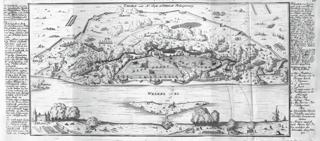
First location in the buildings of post-Franciscan’s monastery, at the back yard of St. Mary’s Church (since 1568 – to 1724; photo WW); second location at Piekary Street, in a building served previously (since 1601) as a boarding house for poorer students of Academic Gymnasium (since 1724 – to 1855); finial location at Zaułek Prosowy (since 1855 – present)
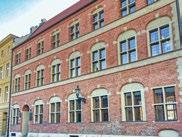

The Gymnasium, officially named the Nicolaus Copernicus State Gymnasium in 1928, and later renamed as the Nicolaus Copernicus High School number 1, is one of the oldest schools in the country.
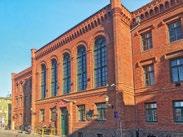


25
[9] Constitution of 3 May 1791 was the first in Europe and the second national constitution in the world, just after the United States Constitution of 1789. It changed the system of the country from a monarchy to a constitutional monarchy, in which the monarch had to follow the rules of the written constitution and serve the country in a rather ceremonial capacity. It was written to establish the legal system in the Polish – Lithuanian Commonwealth, dividing power into executive, legislative and judiciary branches. However it did not last for long. The Second and Third Partitions
of Poland in 1793 and 1795 marked the end of the independent country until the Versailles Treaty in 1918, which ended the First World War. During this period when Poland was not on the map of Europe, the 3 May Constitution functioned as a symbol that supported the dream of all Polish patriots for the country to become independent again.

[10] The Duchy of Warsaw was established by Napoleon Bonaparte in 1807 on the territory resulting from the Second and Third Partitions of Poland. In theory it was an independent Polish state with its own constitution, government and army but under the rule of the king of Saxony, an ally of Napoleon. In reality, indeed the Duchy was dependent on the French Empire. In 1812 it was changed into the Polish Kingdom, only to be occupied by Russia the following year. The Vienna Congress in 1815 divided the Duchy among Russia, Prussia and Austria. However, with the majority of its central part with Warsaw, the Polish Congressional Kingdom was established, the state connected via the personal union with tsarist Russia. This means that its description as “Polish” was rather misleading since the problem of self-governing Poland as a state from before the Partitions was still not solved.
[11] Vienna Congress was a diplomatic meeting of the rulers of European countries, organized between November 1814 and June 1815 in Vienna. The main purpose of this meeting was to discuss changes of the existing territorial and political conditions in Europe at that time. In general, it established the rules of international politics keeping peace in Europe until the First World War in 1914. Based on the decisions made in Vienna, the former invaders of Poland, namely Russia, Austria and Prussia, gained the most territory divided among the powerful countries. In particular, Chełmno Land with Toruń was back again under the Prussian administration.

26
The Constitution of 3 May 1791, oil painting by Jan Matejko (Royal Castle in Warsaw, photo Adrian Grycuk, public domain via Wikimedia Commons)
Between Earth and Heaven; Between Ground and Sky



II. Between Earth and Heaven; Between Ground and Sky
…Toruń bardzo pięknymi budynkami o dachach z połyskujących dachówek tak znakomity, że prawie żadne inne miasto nie może się z nim równać pod względem piękności położenia i świetności wyglądu
…Toruń with very beautiful buildings and roofs made of red tiles, so magnificent that no other town can be compared with its beauty of location and great appearance
Jan Długosz
Jan Adamczewski “Mikołaj Kopernik i jego epoka” (Wyd. Interpress, Warszawa 1972, str. 16)
Copernicus’ City of XXI century, seen by Toruń Angels, has been recorded photographically by Włodzimierz Werner from five observation points:
• Church of St. Jacob the Apostle (2008),
• Cathedral of St. Johns (2010),


• St. Mary’s Church (2013),
• Evangelical Church of St. Szczepan (2017),
• City Hall (2019).
The photographs in the album are presented in chronological order, as they were taken, and various directions of the camera lens are shown on small orientation maps.

Every set of photographs is preceded by the views of each church and the City Hall that are seen from the ground, as they are observed by tourists visiting the town. These are exactly the views of historical buildings that are seen also by an angel who lowered down his orbit and is guarding the passers-by in front of the Collegium Maius, for example. These photographs, taken by Andy Hess,
are presented together with short historical information about each point of observation including data on sizes of towers, mainly to show from which heights Toruń was observed and documented by camera.
Historical information and data have been taken from the following sources:
Teresa Borawska and Henryk Rietz, “Przewodnik po Starym Toruniu” (Adam Marszałek, 1994),
– Tomasz Jaworski, Marek Nasieniewski, Krzysztof Przegiętka, “Dzwony Starego i Nowego Miasta Torunia – stan obecny” (chapter in “Tajemnice starych dzwonów Torunia i Chełmna w 500-tną rocznicę ulania wielkiego Tuba Dei spisane” (KNOiK, Toruń 2001)).
–
29


30
St. Jacob’s church
The Gothic church of St. Jacob the Apostle was built in the years of 1309–1421 by the Teutonic Order. From the beginning it served as a parish church for the residents of the New Town (Nowe Miasto). At the same time it also served as the main church for the Knights living in the nearby castle, just at the Wisła (Vistula) bank. In fact, from the very beginning the church was under the care of the Teutonic Order. In 1345 it was turned over by the Grand Master of the Knights to the care of sisters of the Cistercian Monastery. Since 1425 the church was under the patronage of the nuns from the Benedictines, until 1456 when the City Council of the unified Old and New Towns took over its protective care.
In 1557 it became a protestant church, therefore some changes of the interior required by the Lutheran liturgy were introduced (and only recently, in 2021, was it brought back to its original Gothic beauty). After 110 years of Lutheran denomination, again it was under the care of Benedictines, and the nuns were there until dissolution of the order in 1832. This was the year when the church was dedicated to St. Jacob the Apostle and became the Catholic parish for the New Town.


What is the history of this massive building in this magnificent Gothic brick style?

By 1340 the three-nave construction was finished, and the tower was completed at the height of 49 meters in 1350. The two-fold roof on the tower was constructed after a fire in 1455. This is in fact the only medieval church in Toruń that is constructed in the style of a basilica, which means that the main nave is higher than the side ones. In addition, as typical for this style, there are windows in the main body of the building that are above the side naves. The main nave is 20.65 meters high; the height of the side naves is 9.40 meters and the church is 53 meters long and 28.8 meters wide.

In the church there are three bells and one turret bell: a bell from the turn of 14 th and 15 th centuries (1.05 meters), one from 1770 (0.77 meter), a bell from 1847 (0.96 meter) and the turret bell from the turn of 19 th and 20 th centuries (0.30 meter).

31


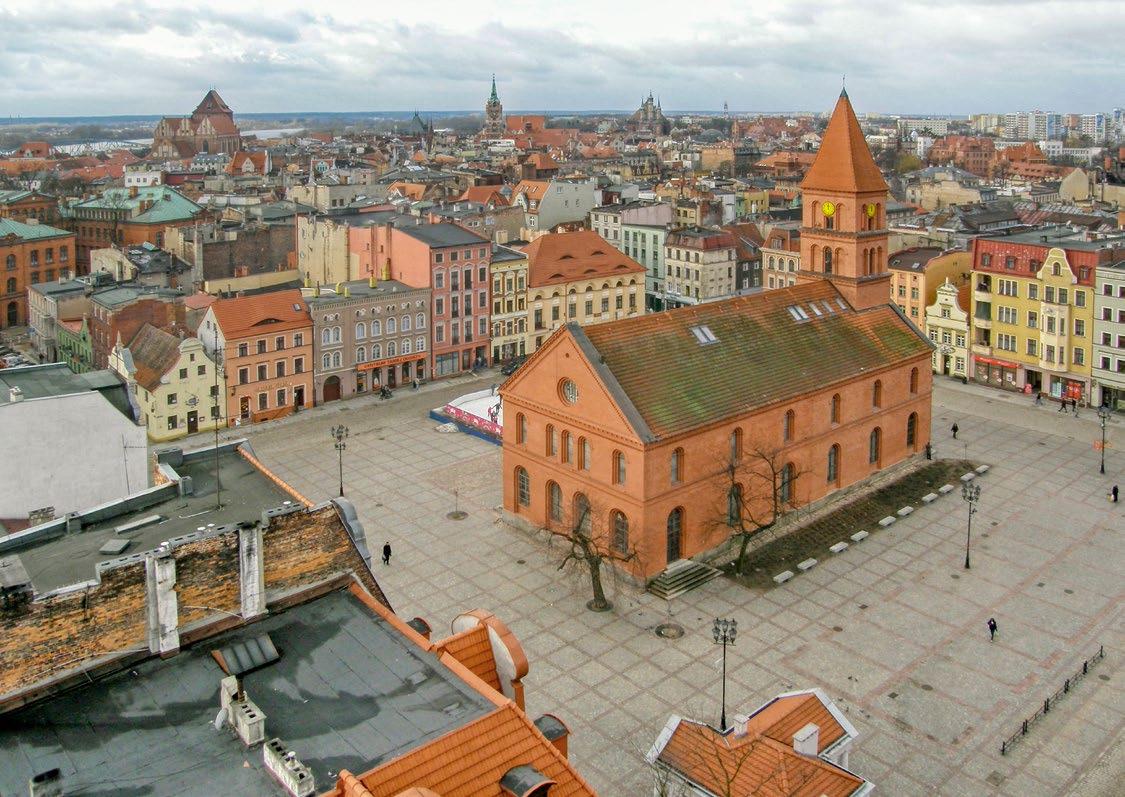 New Town Market
New Town Market






33


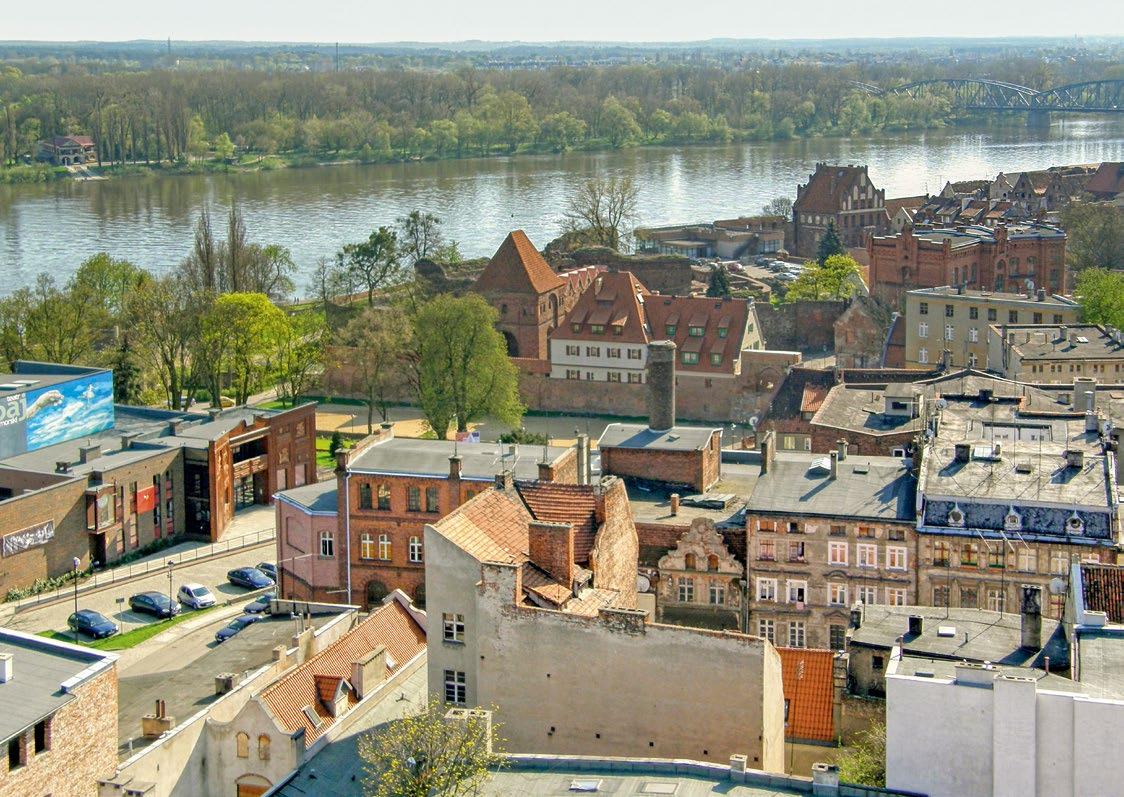 In a distance the Sewage Tower of the Teutonic Knights’ castle (13 th century)
In a distance the Sewage Tower of the Teutonic Knights’ castle (13 th century)






35


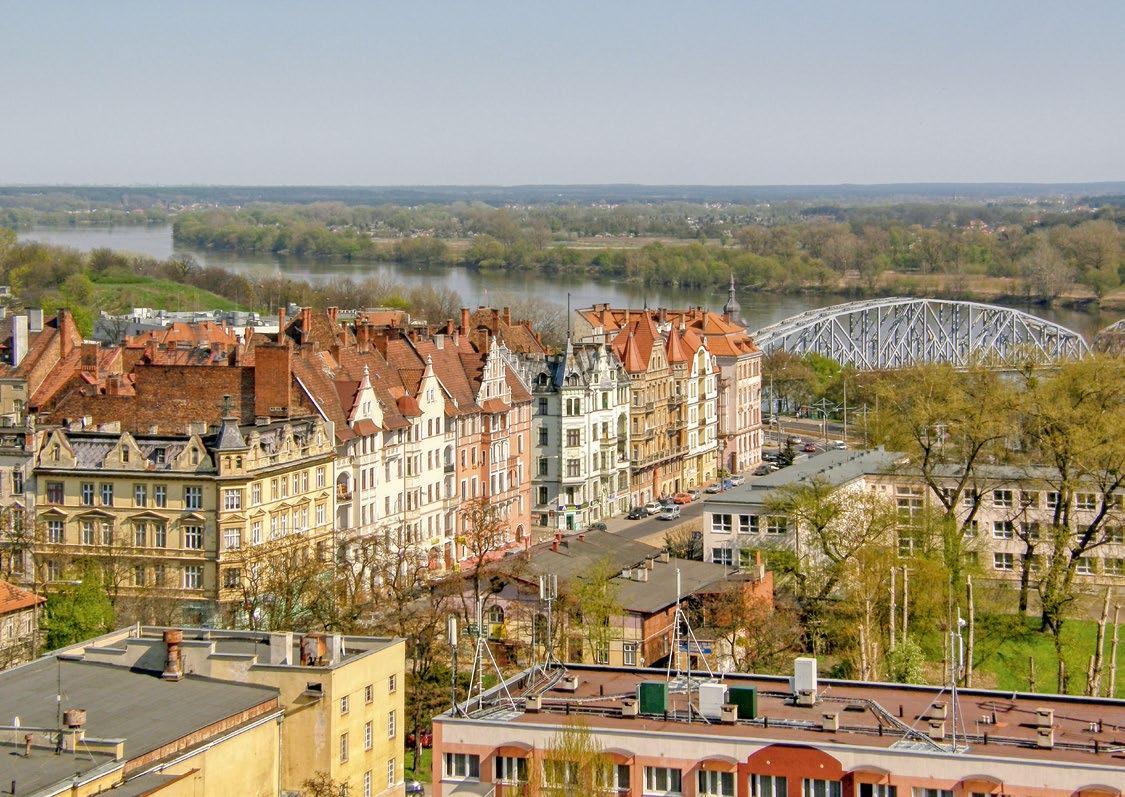





37


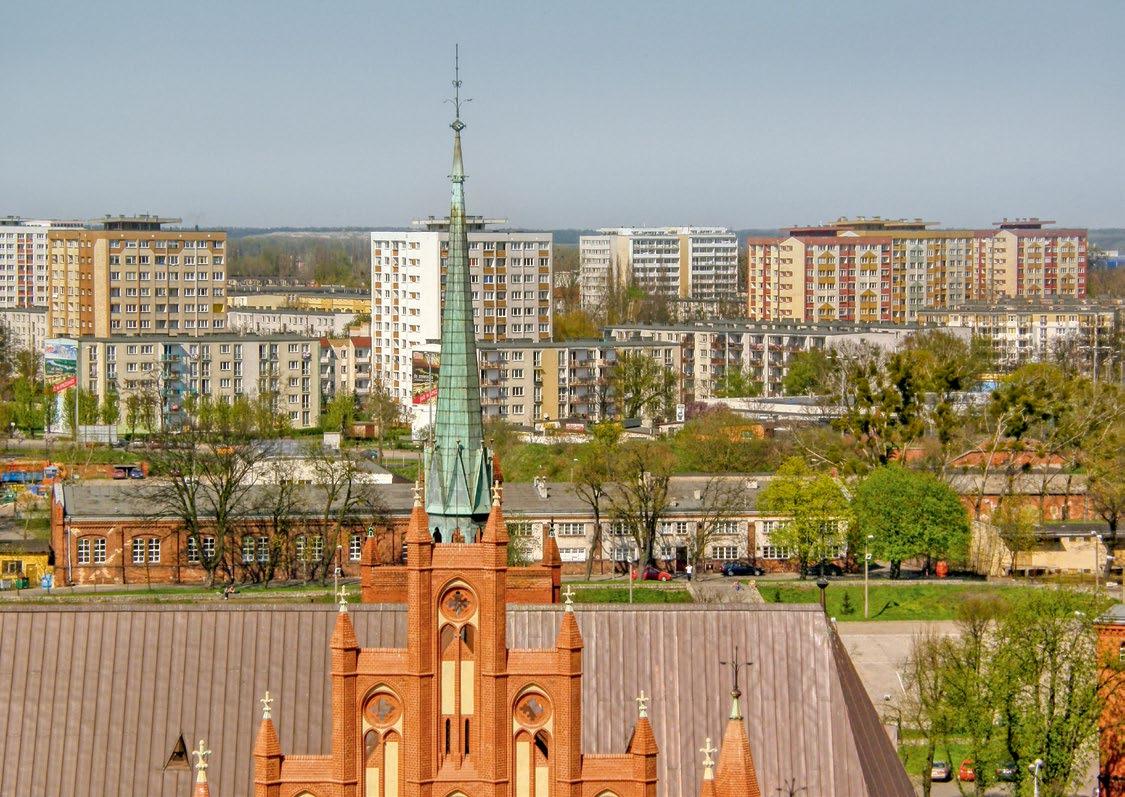






39





40
Cathedral of St. Johns
The Cathedral, as a parish church of St. John the Baptist and St. John the Evangelist, was under construction from around 1260 until the end of 15 th century. This building was the center of life of town until 1518, and even the election to the City Council was held there, not to mention visits of members of nobility and distinguished royal guests. In 1530 the church, initially Catholic, was taken over by the Protestants, but after 53 years they allowed the Catholics celebrate in the church their own liturgy. In 1596 the Jesuits took over the church, and it was Catholic again without any restrictions or limitations. This association lasted until the dissolution of the Jesuit Order in 1773 when the church became the main parish for the residents living in the Old Town of Toruń. In 1992 the St. Johns’ Church was elevated to the rank of cathedral for the newly established Toruń Diocese.
The Cathedral is a massive building of a hall-type construction, with three naves, lower presbytery and side chapels. One of these chapels is devoted to Nicolaus Copernicus where there is a baptismal font from 13 th century at which perhaps astronomer was baptized. Since the construction of the church its size has not been changed: its length is 53 meters, the naves with the chapels are 32.20 meters wide, and their height is 27.30 meters, while the height of the presbytery is only 17 meters. These measurements show from which height Toruń was photographed in 2010. This is even more impressive, realizing that the four-side tower, from which actually the photographs were taken, is 52 meters high, and indeed it is the highest observation point in the Old Town of Toruń. The tower was erected in the years of 1407–1433, and its walls are four meters thick; perhaps this is why it is still standing straight! In 1500, on the highest level of the tower the Tuba Dei was installed, the historical bell (diameter 2.27 meters and weight of 7238 kilograms) that is responsible for the Angel’s patronage of Toruń, as a legend proclaims. It is the largest Medieval bell in Poland, and it is still installed on the original wooden beams.
In the same tower there are other bells: Funeral bell (0.95 meter) from 1412 and Lame bell (1.22 meters) from 1766.





41


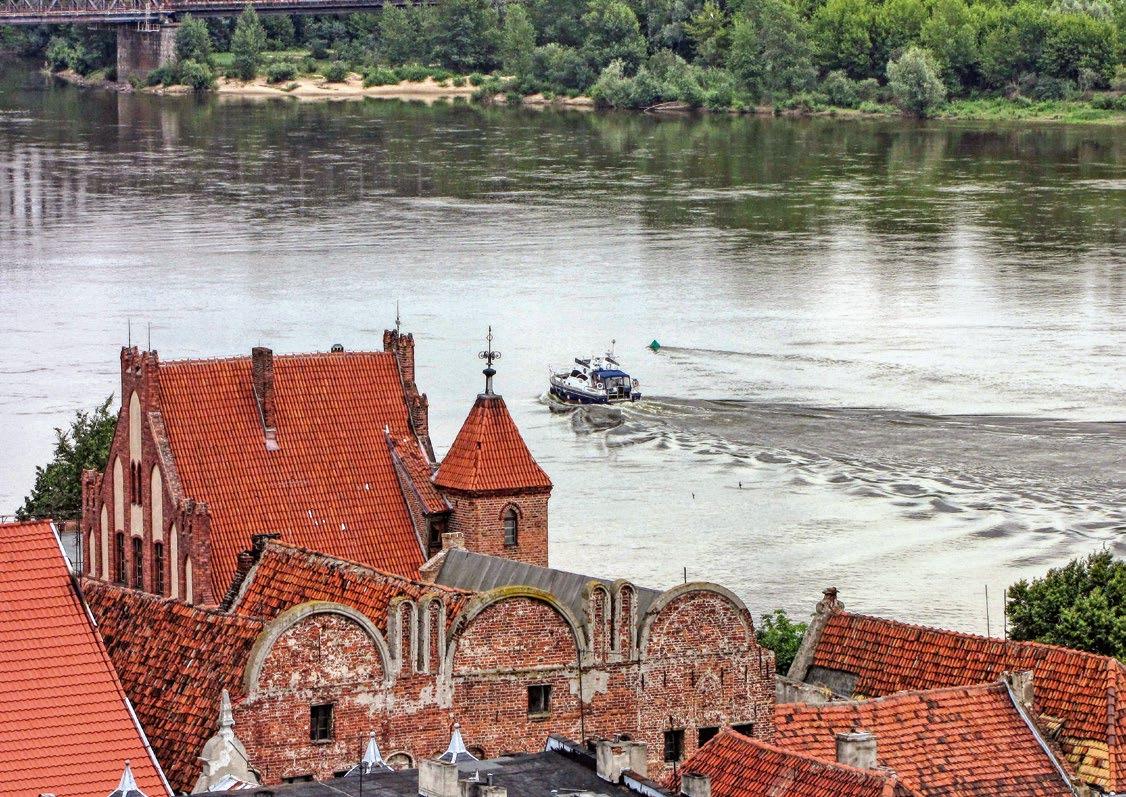 Manor
Manor
–
Dwór Mieszczański (built in 1489), former seat of the Shooting Brotherhood of St. George, established in Toruń in 1352 (Strzeleckie Bractwo Kurkowe)






43




44
Leaning Tower, medieval city tower with the deviation of its walls from the vertical by 1.46 meters


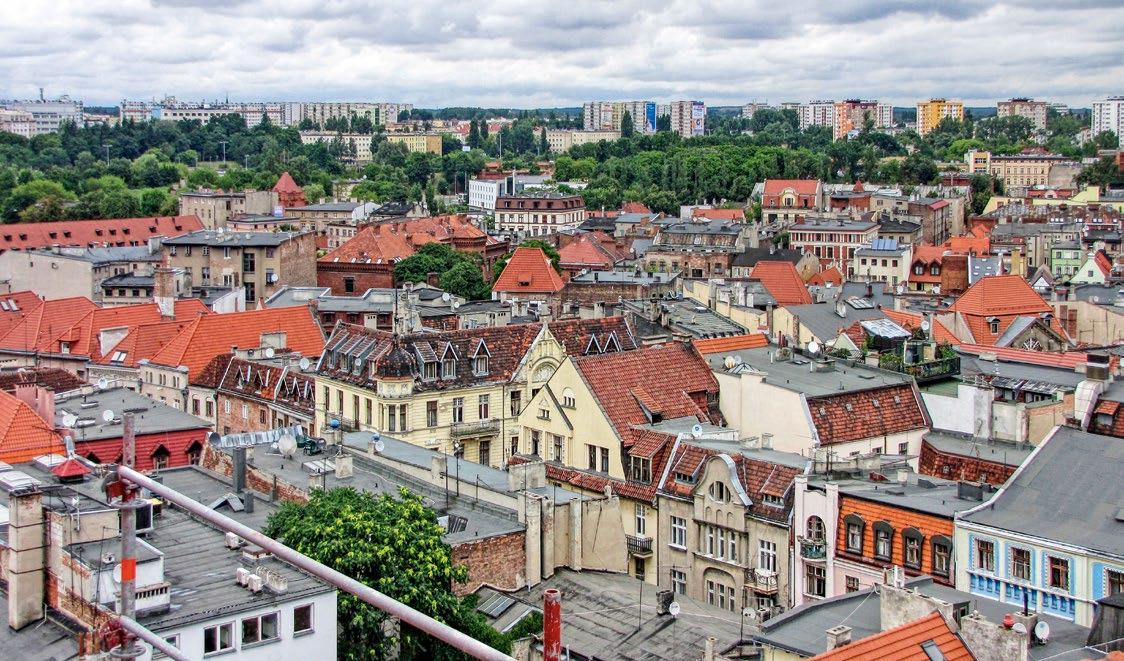
45

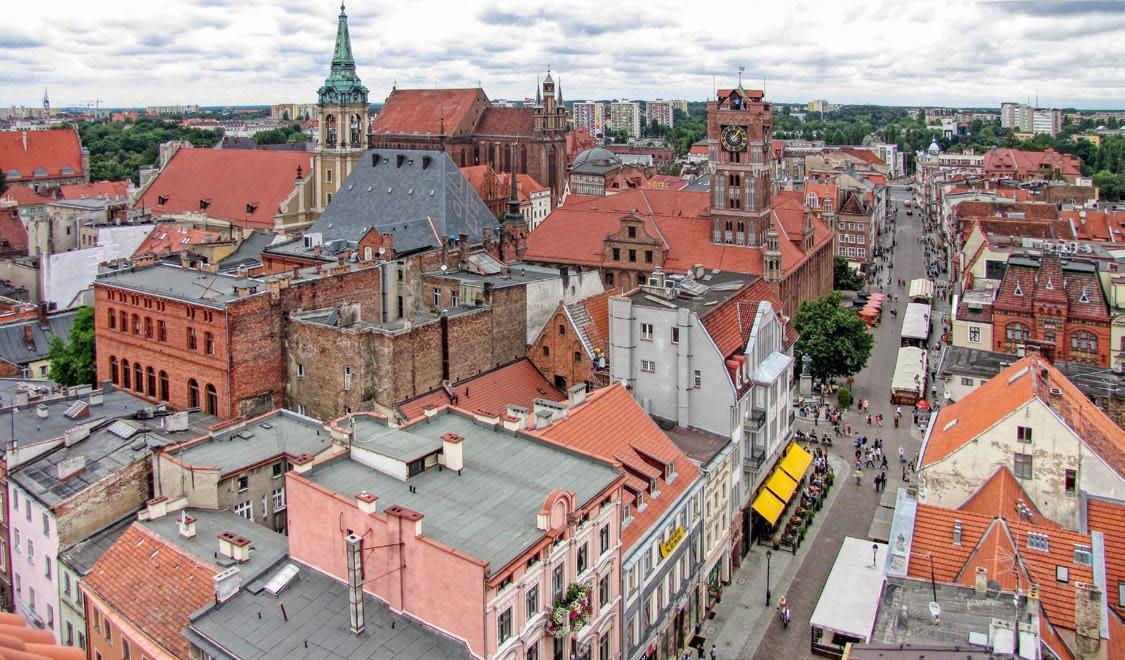
46





47

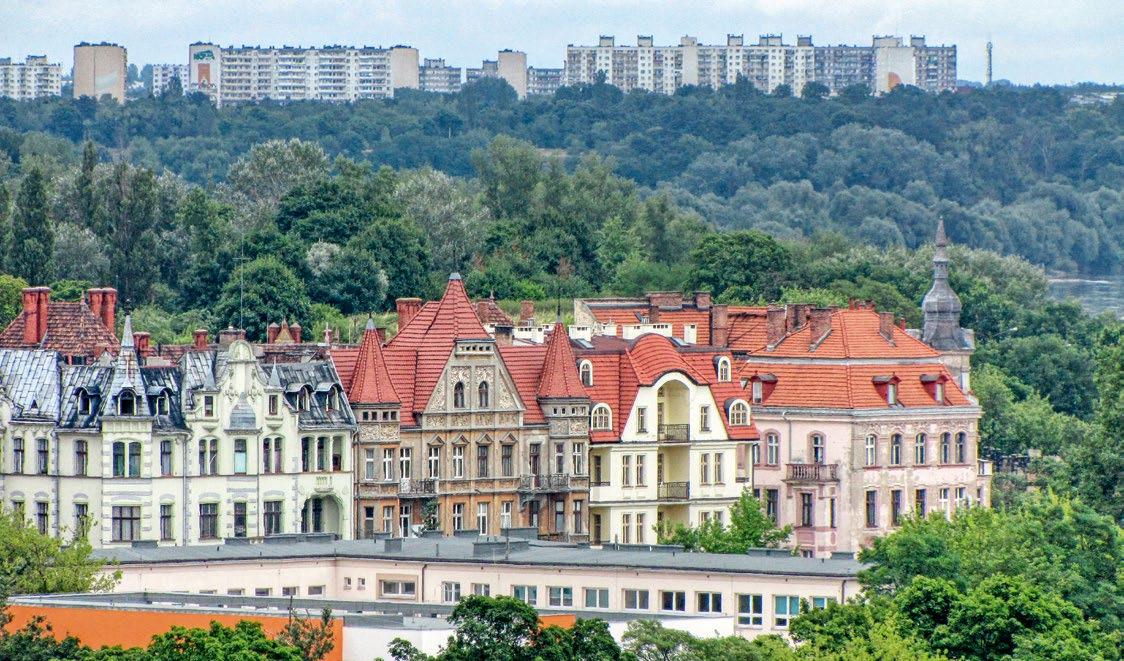
48
St. Mary’s Church is the post-Franciscan temple devoted to the Assumption of the Blessed Virgin Mary. The massive building was erected in several stages starting in 1343, and ending at the end of 14 th century. When the monks arrived in Toruń before 1239 and the Franciscan Monastery was established, they found the third version of a church that already existed in the same place. Thus, finally it is a red brick Gothic building in a hall style with three naves, asymmetric, with the length of 66 meters, the height of almost 27 meters, and with naves 25 meters wide. Following the rule of the mendicant order, instead of a tower, the church has octagonal turrets. In the beginning, each nave was covered by a separate roof, but at the end of 18 th century the whole construction of the church was covered by one common gable roof.
In 1557, during the era of Reformation, the care of the monastery church was given to the city, and it became the main Evangelic temple for the residents of the Old Town. Beginning in 1568 the monastery buildings were used as a home for newly created Protestant Toruń Gymnasium (introduced in the previous chapter).



After the so-called Tumult of Toruń in 1724, the religious conflict between the Protestants and the Catholic students of the Jesuit school, the monastery and also the church again were under the care of Catholics, the monks from the Bernadine Order. They were in charge of the whole complex until 1821, when the Order was dissolved, and all the buildings of monastery were given to the city and later demolished.
In 1852 a new and independent parish was created. Since 30 March 2001, in addition to the original devotion to the Assumption of the Blessed Virgin Mary, the church and the parish have been devoted also to Blessed Stefan Wincenty Frelichowski, a local priest who was killed by the Germans in a concentration camp during the Second World War.
In the church there is the bell St. Lawrence (1.06 meters) cast in 1386. Note that there is no tower at this church to climb in order to photograph the views as seen by Toruń Angels. Therefore, the pictures were taken from the scaffolding around the roof during its renovation and restoration in 2013.


St. Mary’s church
49

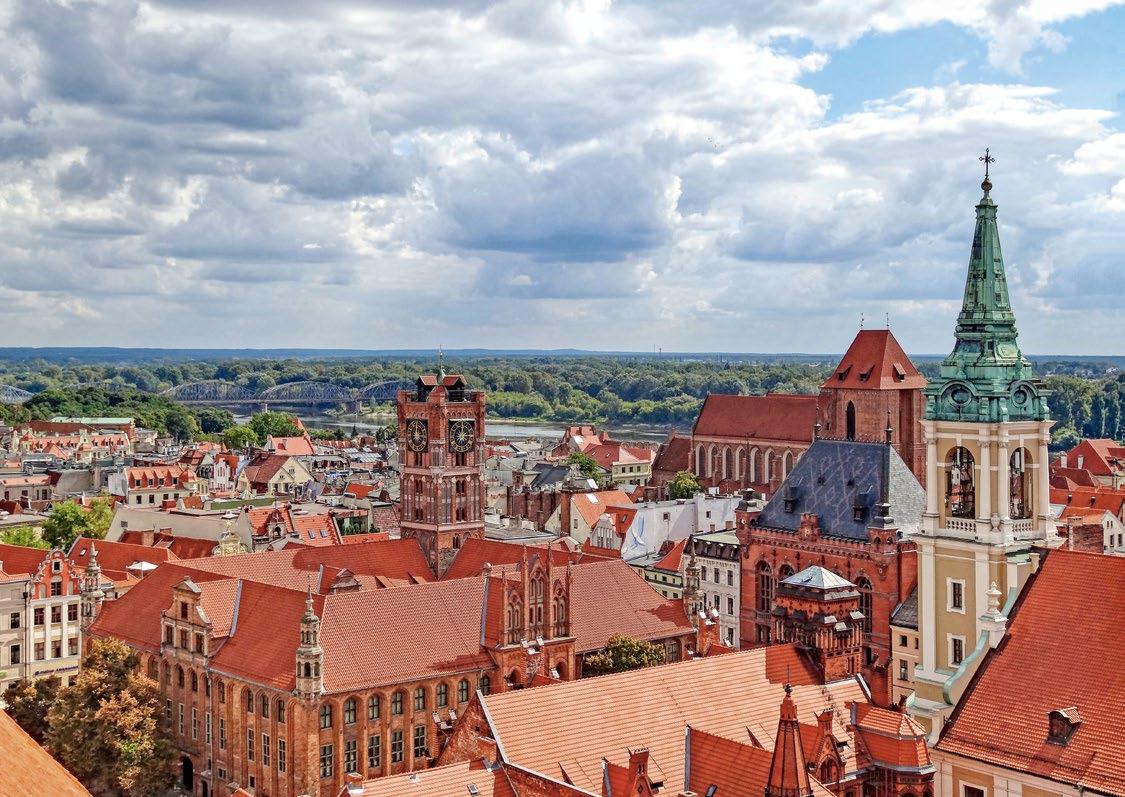





51


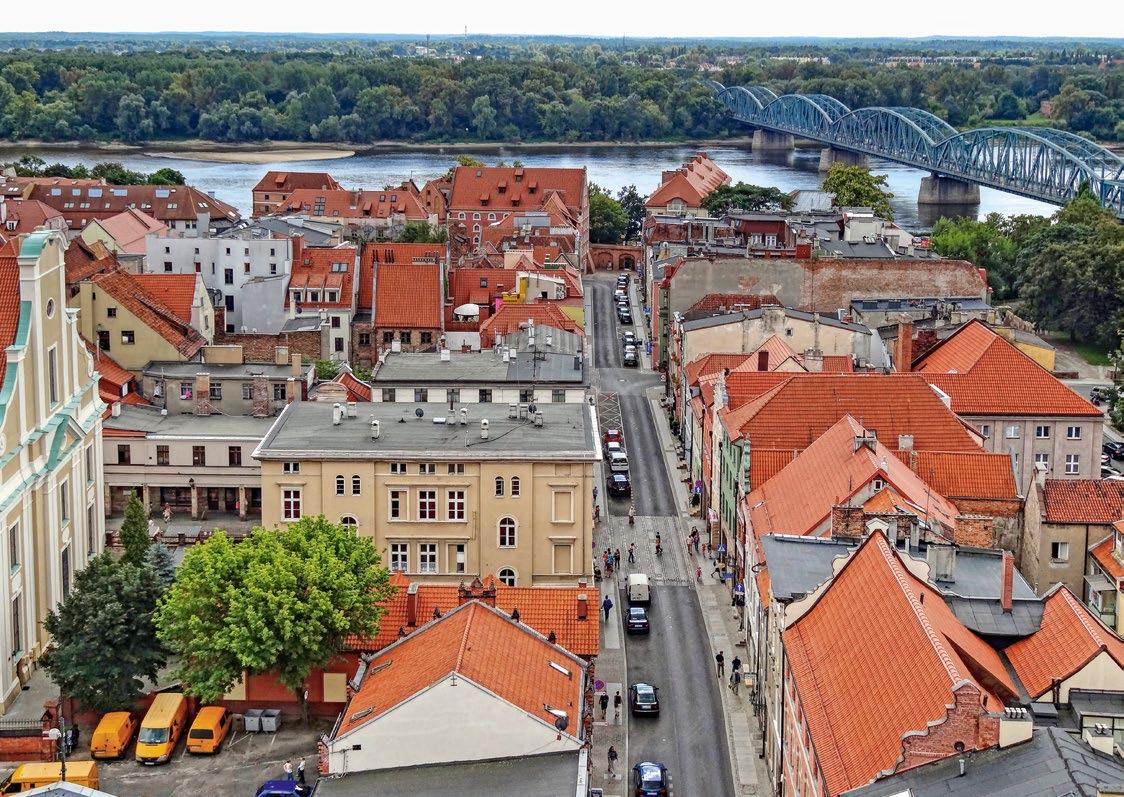



53


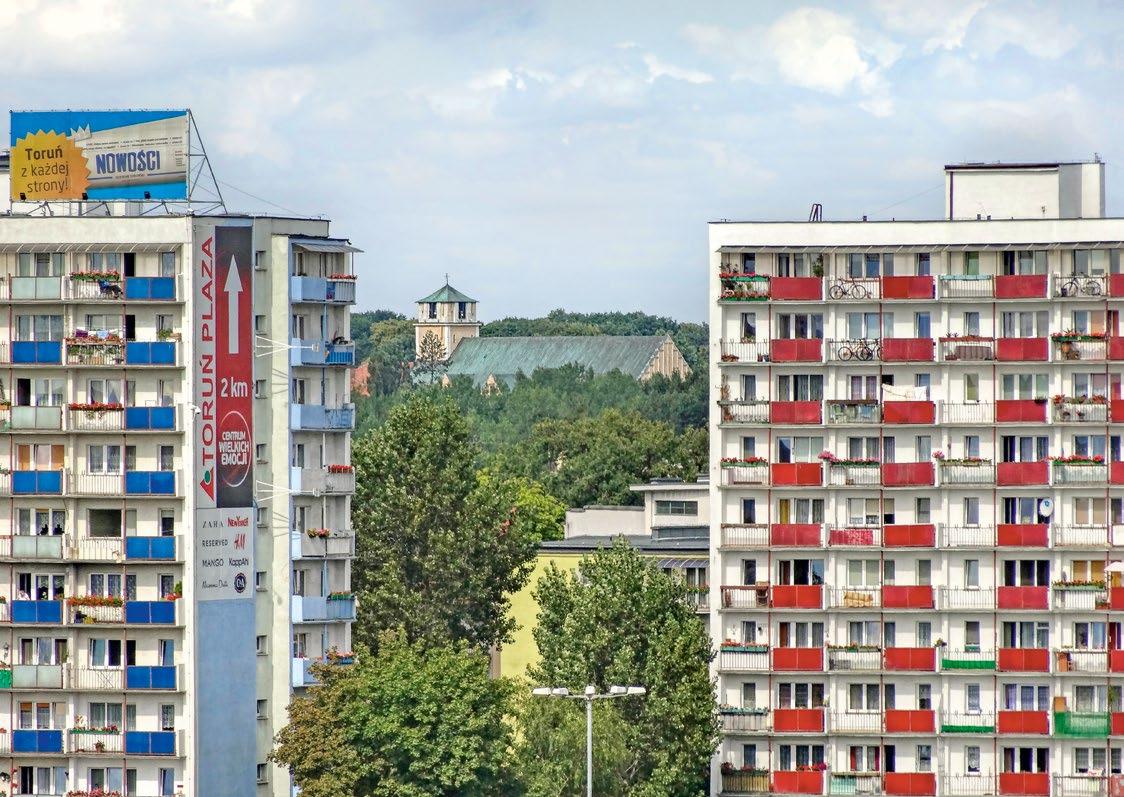






55


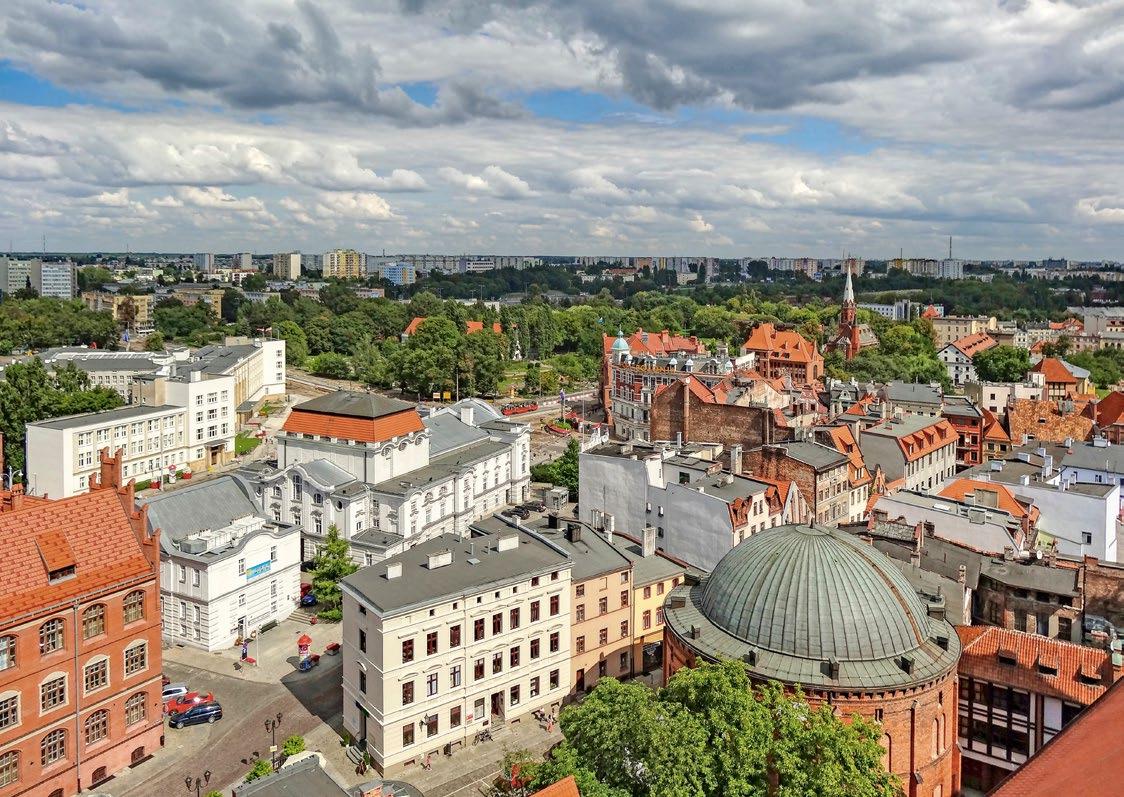






57

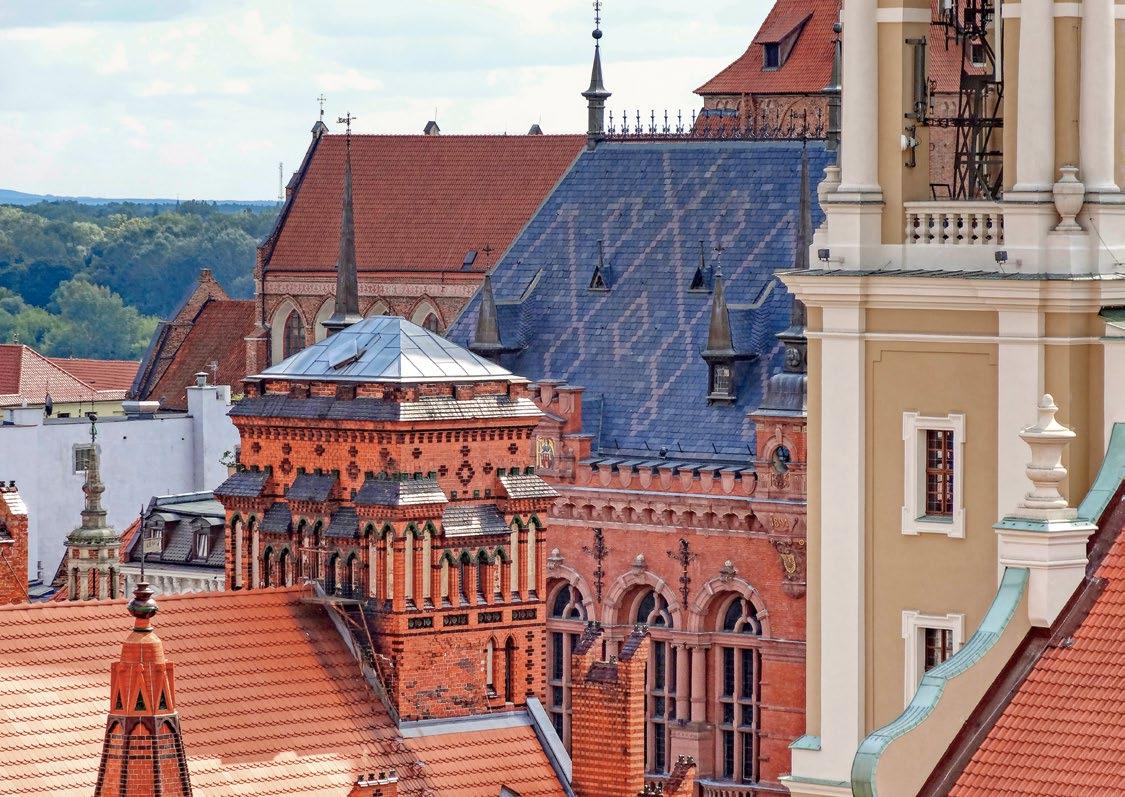
Evangelic church


The Evangelic Church of St. Szczepan is of Neogothic style. It was built in the years 1903–1904, and it is placed on a buried moat which was originally surrounding the Old Town. The church has two naves 22 meters long and 11.5 meters wide, and what is important for this presentation – with a tower of 49.5 meters high! This is the second highest observation point in town, just after the cathedral tower of 52 meters. This ranking covers the high points within the Old City. Indeed, in the historical New Town there is the St. Jacob’s tower also of 49.5 meters, but beyond the city walls in a close vicinity there is a tower of the military church of St. Catherine which is 86 meters high. However, since it has the shape of a very sharp spire, it is impossible to climb it to photograph the views around.


The church was built for the Evangelic-Reformed congregation (Calvinist church) established in 1676. During the Second World War the church was devastated as perhaps a revenge for the aggression and occupation, since the Protestant religion in a general understanding was associated with Germans. Since the liberation in 1945 it has served as the Lutheran parish devoted to St. Szczepan.

59


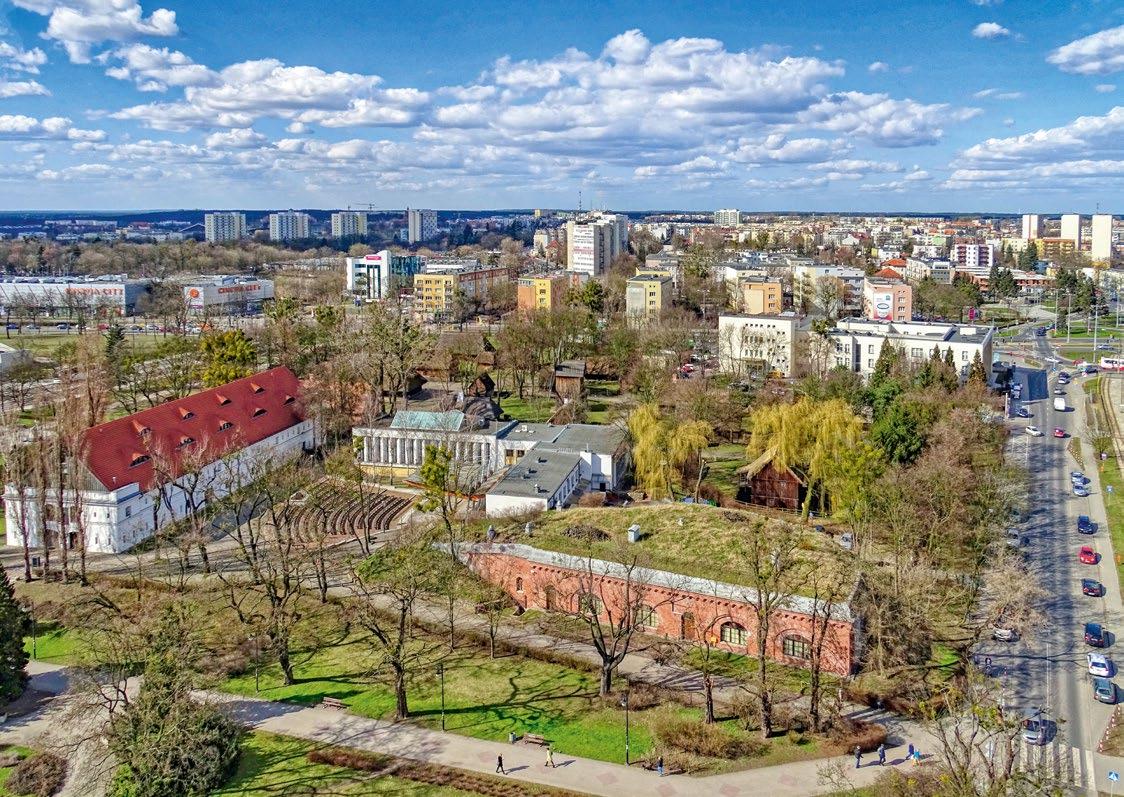



61


62



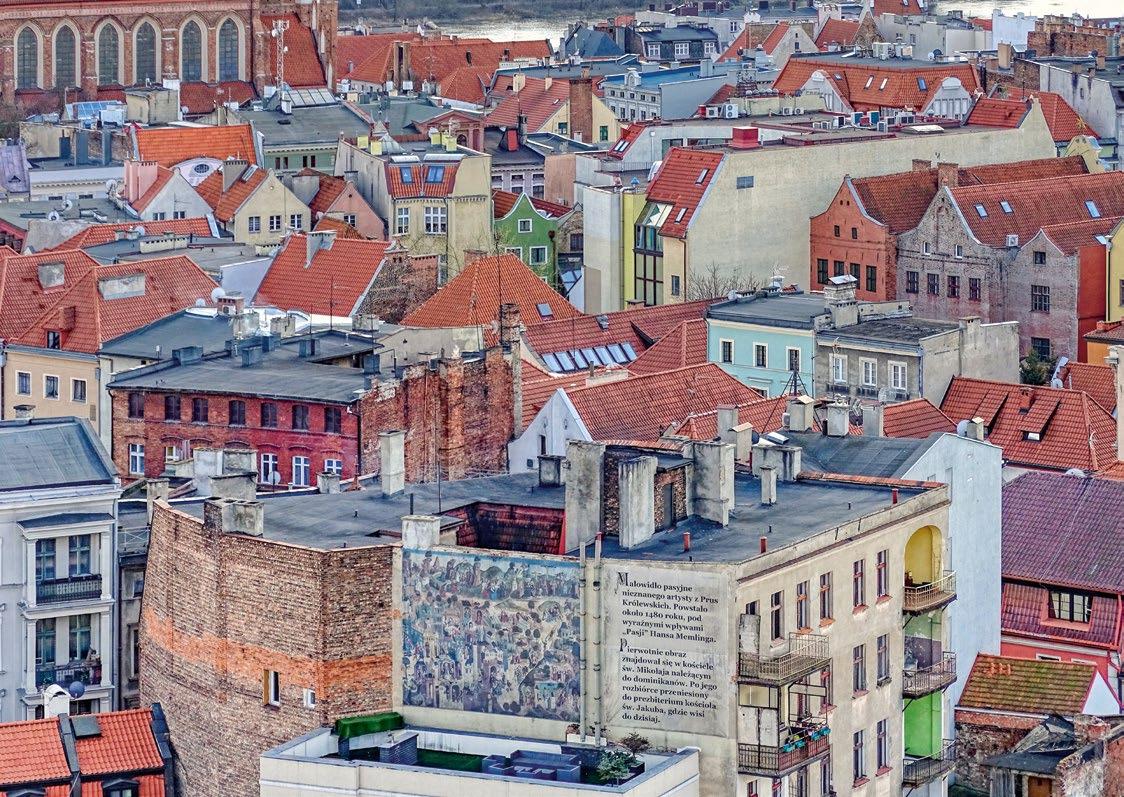





64






65


 Dominican Square and outline of the foundation of the St. Nicolas’ Church built in 1334 and demolished in the first half of 19 th century
Dominican Square and outline of the foundation of the St. Nicolas’ Church built in 1334 and demolished in the first half of 19 th century






67

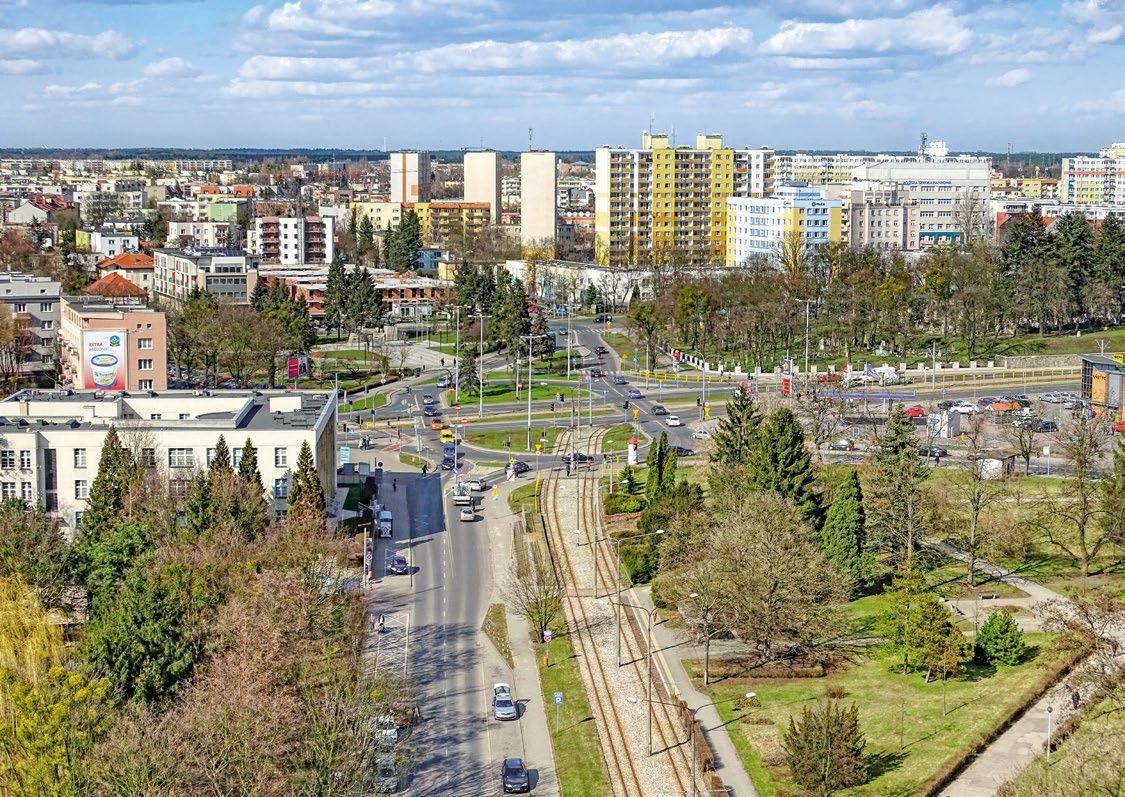
City Hall
The City Hall stands in the very same place where in 1259 there was a building, although completely different, because it was built of wood! In 1385 its overall shape was modified with the tower raised to 40 meters. During the centuries it underwent several modifications of its architecture mainly to adjust it to the demands and expectations of modern trends that were changing over the years.
In 1393 on command of the Great Master of Teutonic Knights, Konrad Wallenrod, the building was completely destroyed. The new construction based on the quadrangle was completed before 1399. The next modification was during the years of 1602–1603 when its style was adjusted to the requirements of Dutch Renaissance and an additional level was added to the existing construction. The original tower was covered by a very majestic helmet with a spire and golden crown, the symbol of the independence of the city and also evidence of its granted royal privileges. During the Swedish invasion in 1703 and the heroic defense of the city, fire completely destroyed the building together with the art, library, documents and archives. At that time, the helmet with the crown was also burned. Only the observation terrace was left, in fact the same, from which it is now possible to see Toruń… from the position of its Angels!

The damaged construction by fire, except the tower, was repaired and rebuilt during the years 1722–1737.


Since 1958 the City Hall is a home of the District Museum. The basements and the ground floor of the building reflect the Gothic atmosphere of the city, while the first floor shows its Baroque influence.

69


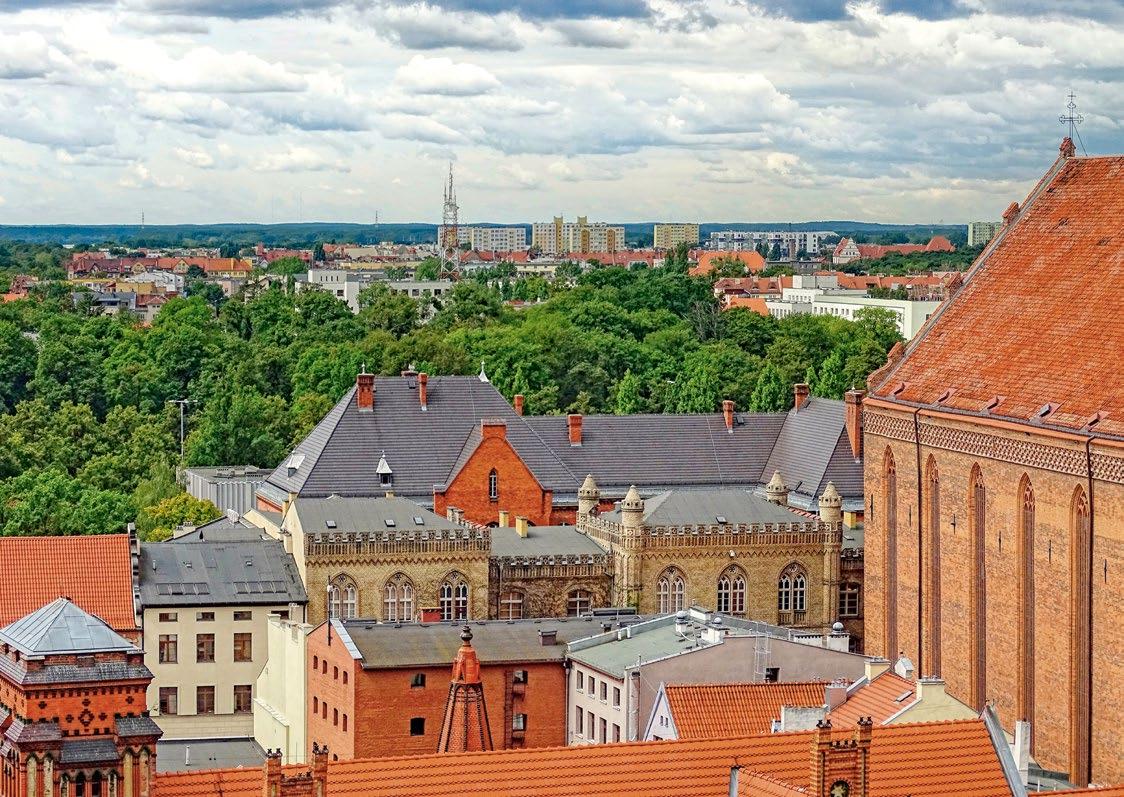



71





72


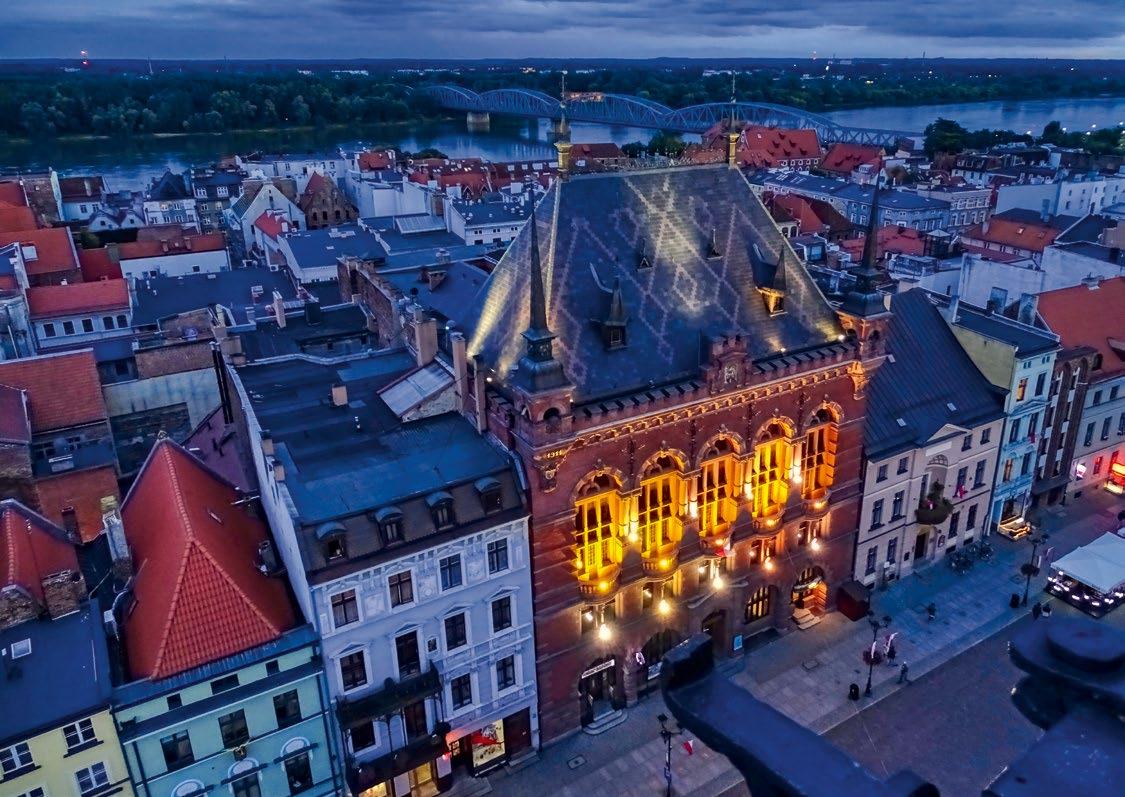





74






75

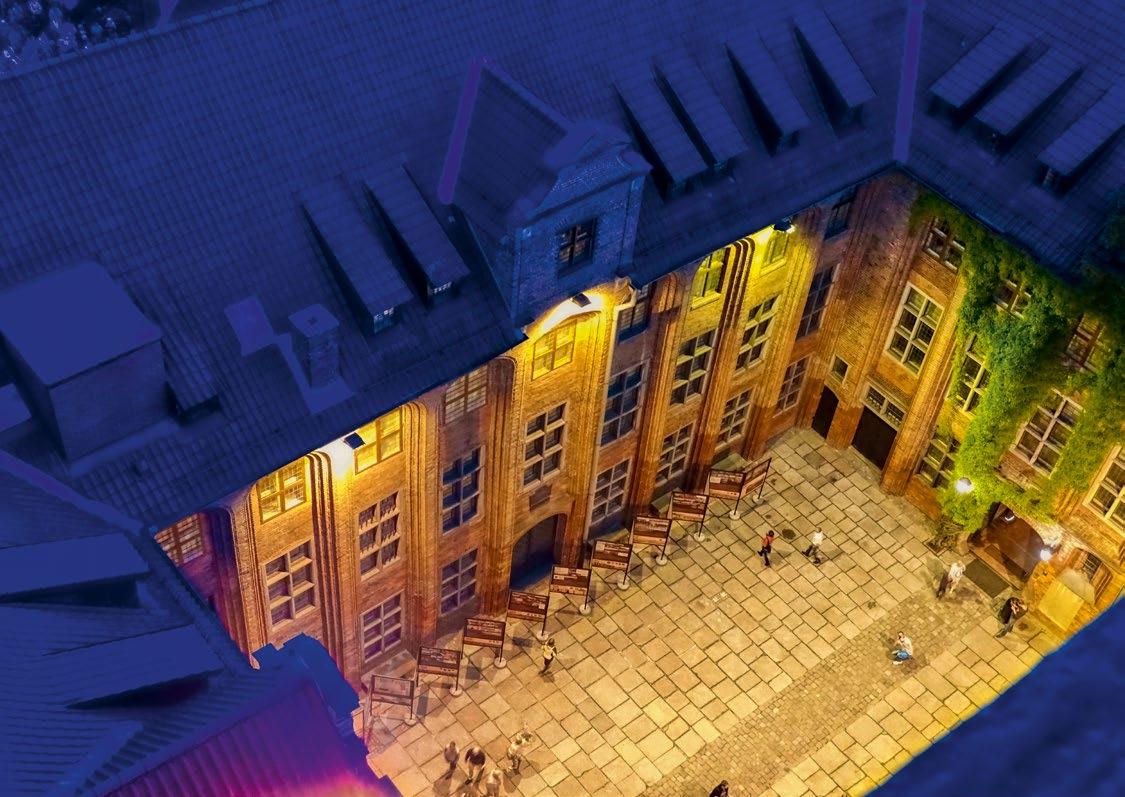
Gothic to Touch



III. Gothic to Touch


Gothic to touch is a promotional slogan often used to encourage tourists to visit Copernicus’ City. It was an excellent opportunity to see the reality of this slogan when taking pictures of Toruń from above, from towers of churches in the Old City and from the observation platform of City Hall. The photographs taken from such positions show the elements of medieval art, which are not seen when walking down the streets and looking up to see the overwhelming size of all these buildings.
Some historical details are explained here in a short interview with the bell ringer of the famous Tuba Dei (the God’s Trumpet) in the Toruń Cathedral, Dr. Krzysztof Przegiętka. He is one of the bell ringers who is very close, just for a touch, to the history from centuries ago when the music of the bell was announcing special occasions for celebration. Dr. Przegiętka also identified the bells pictured in the photographs taken in the bell tower and is an author of the description of their history and fate during the past centuries.
– How did it happen that a physicist with a PhD became the bell ringer of the historical Tuba Dei, the largest medieval bell at Wisła (Vistula) bank? What must be earned in order to receive such a distinction and honor?
I do not remember an exact date, but I was still a student of primary school which means that it was before 1984. Thus, at that time my God father, Ryszard Grzywiński, the head and the organizer of the bell ringers team asked me to come up in the tower of the St. Johns’ Church to see and listen to the music of Tuba Dei. Obviously, I was not allowed to rock the bell right away, but at first I had to observe how it is done by the experienced ringers. At that time the bell tower was not accessible to visitors, as it is now. Its interior looked like the attic of a huge old house with many objects with historical roots but without orderly arrangement. For example,
there were pieces of the clock mechanism of the so-called Rafters’ bells: a very large metal cage and a huge wooden drum with metal fittings. The conditions of the bell suspensions also were not in good shape. When walking there everything was creaking and cracking, and one had to be very careful not to fall down a hole or not to be hit in your head by something falling.
But the halo of the mystery obviously was unusually fascinating for a young boy. Besides the bell ringers and workers repairing the roof from time to time, nobody was climbing up there. On the highest point of the tower, however, without any problem and without any admiration of the history around, as if nothing had happened, a beautiful kestrel was living having a quiet life undisturbed by intruders.
– Tuba Dei has been ringing since 1500. Which feelings are dominant in the heart and mind of a bell ringer when he is realizing that these very tunes, this very same music could have been heard by Nicolaus Copernicus, who in fact as a child was living within a block of the church?
These special feelings are not reserved only for the bell ringers, they are experienced by everyone who is hearing the sound of the bell, and who is ready to devote a moment for the reflection that together with this music the real voice of the Past is coming forth. The city has changed dramatically during the centuries, but its original character has been preserved. Listening (not only hearing) to the music coming from the St. Johns’ bell tower it is possible to go back in time and imagine how it was here before, in the past. It is enough to use your own imagination. Even for a layman, not an experienced person in recognizing various bell tunes, it is easy to distinguish the music of Tuba Dei: low frequency of the tune, a dignified, calm and majestic rhythm; at once you feel that this music is coming from a medieval colossus.
Kestrel – the sole inhabitant of St. Johns’ bell tower, now from next generation but still it observes the continuity of the Tuba Dei bell ringers’ tradition (therefore not by accident this photograph, taken in 2010, is among the illustrations of this chapter)
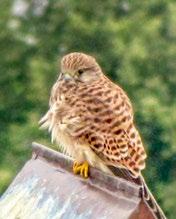
79
This is true, the bell ringers are indeed in a special position also because their work is included in a long tradition of previous generations.
I know that every bell ringer is treating this service as a special distinction, honor, privilege and the chance to be close to the valuable monument of the past; unique, a huge and still working musical instrument, which at the same time, is the best example of the European foundry at its highest level of art. The privilege – yes, but also duty to keep the continuation of this tradition and convey it to the next generation together with the education about the bells and their importance in history. It should also be pointed out that Toruń bell ringers are proud to do this without any financial benefit.
– The position of a ringer of a historical bell is indeed an exceptional distinction and a special privilege to have access to all the secrets hidden in such historical places as this one in the bell tower of the Toruń Cathedral. Would you be willing to share with us some of them?
Well, the biggest secret is that… there is no secret! Instead there are quite a lot of legends and incredible stories, rather mysterious stories associated with the bell. One of them is the habit to touch the iron heart of Tuba Dei but in a particular place, the thicker point, exactly where it hits the bell wreath. This thickening of the clapper has the shape of a sphere, is round, and it is called a beater. Thus, touching the fresh scar on the beater gives the assurance for happiness and fulfillment of all dreams, but it has to be done with your left hand and just after ringing of the bell; when the place is new, fresh and therefore it is for sure that nobody else touched it before. This is obviously a myth, however such a brotherhood of hearts of men and bells is beautiful, isn’t it?
Before the Second World War another myth was spread around Toruń. It was proclaimed that Tuba Dei had a stationary heart, fixed and still. The origin of this information perhaps was found in the publication from 1933 (and again republished in 1967) by Marian Sydow “The most interesting singularities of Toruń from older years and newer times” where the author indeed described
“The God’s Trumpet” in such a way. Even in the eighties of twentieth century this false description, creating a myth, was supported by sparse photographs of bell as stationary and still, but the pictures were not taken during its ringing.

Such documentation gave a wrong impression. When the bell was not active, in order to relieve the weight from the leather belts on which previously the heart was hanging, a wooden support was put underneath to stabilize it. This technical protection could indeed give the impression that the heart is not moveable at all. From a physical point of view, obviously it would not be possible. This means that deep down at the origin of this description, there was a bit of truth, since there were such moments of stabilization when the bell was not ringing, but unfortunately this picture started to live by its own rights and such a story was repeated many times. It is possible that a similar situation is the origin of the other circulating legends, as for example this one about the founding of Tuba Dei and hoisting it to the highest level of the bell tower.
In the past Tuba Dei was moved in a generally known way, very standard and described in the iconography, literature and movies devoted to the so-called rocked bells in towers (western version of bell towers). It is known that this particular way of moving the bell is based on a rhythmic, alternating pulling of ropes attached to the ends of the beams placed in a perpendicular position with respect to the rocking axis, on both sides of a yoke of the bell where the crown of bell is immobilized. Due to the appropriate length of the beams the bell ringers are away from the space of the bell and its heart movement, but at the same time these beams play a role of leverage due to which it is much easier to rock even a very heavy bell. In addition, above the yoke of the bell there are extra beams that play the role of a counterweight.
In the middle of 19th century the mechanism of rocking the God’s Trumpet was changed and the traditional ropes were replaced by
– How a bell weighing more than seven tons is set to motion and starts to ring?
80
a movable platform thanks to which the force of legs of bell ringers is used instead of their arms. It is arranged in such a way that the bell ringers are climbing up above the bell (and not under as it has been before) to stand with one leg on the movable, swinging platform attached to the yoke of the bell, while the second leg is based on the stable immobile floor permanently connected with the structure of the tower. During such trampling-rocking one has to be very careful not to put a foot between the swinging platform and the stable, fixed floor.
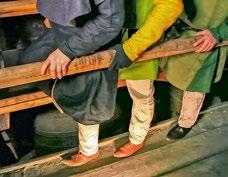
In any case, this way of rocking the bell is more effective. This method became rather popular in Europe, especially in the case of the heaviest bells, also the historical ones; it was popular until the invention of the electric motor which replaced the human power. Currently a lot of bells, also those historical ones, are put in motion in an automatic way using electrical mechanisms.
I mentioned before the brotherhood of the hearts of people and a bell. These are not only empty words. To the list of duties of the bell ringers, in addition to rocking Tuba Dei, also care of the whole instrument and the condition of its work are included. In particular it is important to observe whether its heart is hitting the place within the bell wreath, the thickest point of the bell mantle. It is also important to control the strength of each hit, which has to be at a certain level since the bell cannot be swinging too much. It should be also mentioned that during the ringing special attention must be paid to the tune of the music in order to recognize possible deviations from the normal work but also to control the vibrations of elements of the construction. It requires a lot of experience because each ringing varies a little, and it depends not only on the activity of the bell ringers but also on the surrounding conditions. In the case of the cathedral tower, we – the bell ringers – are taking care of all the bells, which means in addition to Tuba Dei two other historical but smaller instruments which are rocked by the force of arms.
– During religious celebrations of special significance, when Tuba Dei plays the music, you are on the third level of the cathedral tower, very close to Gothic to touch, in the immediate proximity
of the bell. Has this environment full of history been an inspiration for you to write the monologue of Tuba Dei announcing the message addressed not only to all Toruń residents but also to all visiting tourists (poem presented on page 95)?
Awareness of the importance of Tuba Dei as a unique monument of the founding art and its role in keeping the tradition of bell ringing alive was developing inside me with time. In fact, this is a process which still goes on. One of its effects is the interest in history, especially the history of Toruń and Royal Prussia. I realized the depth of my Toruń roots during the year I spent on a research scholarship in a distant, beautiful and attractive Lisbon. As it is well known – from a distance very often everything is seen better. Thus, at that time the bell became for me a source of symbolic identification with the local history and tradition. This was the time when I realized that I belong to this particular place, and this is what I was trying to express in this poem.
– On 18 th of January 2020 we celebrated the jubilee of hundred years of return of Toruń and the whole of Pomerania to Motherland; Tuba Dei announced this anniversary with its music. How often are we able to hear its tunes?

As always in the case of celebrations that are not included in the liturgical calendar, the decision is made by the Church when Tuba Dei is to be rung. It should be pointed out that Tuba Dei belongs to the heritage of Toruń since the time of its greatest glory, when the city was one of the richest cities in Poland during the so-called golden age. Therefore, it is universally recognized as a symbol of prosperity of the town and the whole country. As the pride of Toruń residents, the bell is a unifying force of all people living here regardless of their political orientation and even professed religion. It is worthwhile to recall that Tuba Dei over the centuries was ringing for Catholics as well as for Protestants living in the Old City; similarly as the present Cathedral of St. Johns served in the past as a temple for both denominations.

81
Rocking the bell
The spiral staircase in the cathedral bell tower leading to the third floor where all the bells are now housed (bell chamber), including the famous Tuba Dei. Along the western wall there are two staircases – the southern and the northern. From the third level it is possible to climb higher, to the very top of the tower where the bells originally were hanging, directly under the gable roof (different shape from the present) with openings allowing the sounds of the bells to freely escape and reach all sides of the world. On this path up, there is only one stairway, along the southeastern edge of the tower, and on the way there is an entrance to the chamber with the mechanism of the Rafter’s clock


The oldest cathedral bell, cast in 1412, the so-called Funeral Bell, was also renovated in 2008, and among other repairs, a new heart (a new clapper) was installed. The name of this instrument comes from its ringing during funeral services. It is rocked in a traditional way by ropes pulled by the bell ringers. In the past these ropes used to be lowered through special openings down to the ground floor thus enabling ringing without the need to climb up to the bell chamber on the third level of the tower


82
cathedral
Bell Tuba Dei seen from the northern side with the relief of St. Barbara. Inside the instrument, at the bottom edge (the so-called mouth of the bell)


it is possible to see the mark made by impact of the original clapper (heart), a scar dated from 1500 to around 1898; it is rather large and is covered with a patina. There is also a newer mark, that appeared after 1900, which is smaller and brighter, since it is rather recent. The wooden construction that lifts the Tuba Dei is from the second half of the 16 th century, and it is a reused part taken from the younger (cast in 1589 in the foundry of Merten Schmidt) and smaller bell, which no longer exists (around 2.4 tons). At the beginning of 18 th century this particular part of the construction was reinforced to hold the heavier and larger Tuba Dei that during the Swedish war, was moved down to the third level from the higher bell chamber. At the turn of the 19 th and 20 th centuries the suspension of the heart of the bell (the clapper) was repaired and the whole body of the instrument was turned by 90 degrees. The next renovation was done in 2008 and this is why new boards of the rocking platform are seen above, at the level of yoke. On this platform the bell ringers stand and with the power of their legs they swing (rock) the bell. This way of ringing a bell originated in the middle of 19 th century; in this way for example the famous bell, Emanuel in the Notre Dame Cathedral, was rocking in the past. It is interesting to point out that on this photograph dark streaks on the beams are the traces of lubricants used to make the rocking easier. Since 2008 the rocking axis (the bell yoke) rests on modern closed bearings due to which the comfort of bell ringers work is made easier and the conditions are safer for the instrument


83
St. Barbara (photo K. Przegiętka)
The Baroque bell called Lame was cast in 1766 by Mikołaj Petresilge. This bell hung on the south side, is also rocked by hand with ropes. The name of the bell is related to its characteristic, once asymmetrical way of tapping caused by the wear of its suspension (yoke of the bell), and as a consequence the heart of the bell (the clapper) did not tap on one side. In the foreground, there is a beam with characteristic cut grooves for the crown of a bell. In this particular place a large medieval bell (1437), called the Sister, was installed. This was a sister bell in relation to Tuba Dei, because it was hung almost at the same level of the tower, and also because of its size of about 3.5 tons. This second largest bell of St. Johns’ Cathedral, the Sister, was destroyed by the Nazis during the occupation of Toruń (it was sawn into pieces in the bell chamber, then transported down to be used as a raw material for the arms industry).
The fate of the Lame bell was similar but not so tragic. It was removed during the Nazi occupation and taken to Germany (requisition reference number: 2/4/11C), but luckily it was not destroyed and after the war it was returned to its original place in the St. Johns’ Cathedral


A fragment of the smallest and the youngest cathedral bell –Tubula Dei (2002). This is the only St. Johns’ Cathedral bell which is rocked by an automatic electric mechanism, and therefore it is used more often, on a daily basis

84
Decorative finials of church towers and city halls with a cross or small rooster on a gilded ball in which the documents were usually stored, for example with details about the construction of the building or with a description of some historical events




It is possible to experience Gothic to touch also when being high on the scaffolding during the renovation of the roof of St. Jacob’s or St. Mary’s Church. Below there are Gothic ornaments recorded during such occasions. The identification of separate architectural elements that are typical for the Gothic style, and their description have been authored by Dr. Lucyna Czyżniewska, a renowned architect of Toruń.

Tracery is a characteristic form of decoration of Gothic architecture – here as a painted white trefoil on a red background. Sometimes it is also on a black background and in various forms (for example, multi-leaf shape or shape of a fish-bladder), most of all made of stone as a filling of a lancet window, narrow with a pointed arch at the top

85
st. jacob’s church
Characteristic of Gothic architecture spire-like pinnacles, often decorated with crockets, which are the ornaments carved as curled leaves or flowers equally distanced, and opened outwards in relation to the surface of their attachment. When made of profiled bricks these decorations give the impression of the lightness of the pinnacle

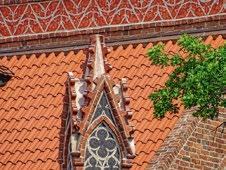


Blind lancet window of the turret-like pinnacle filled with painted tracery, which shows the division of the panel into two identical sections by the mullion, the vertical line with a sharp arch at the top. The pinnacles also played a constructive role, since they support the stability of the buttresses by counteracting the lateral thrust of the roof, as in the case of St. Jacob’s Church
Example of a tracery painted on a black background. Here as a decorative motif the shape of a fish bladder was used (collected in the form of triangles) and also the quatrefoil (as four overlapping semicircles)

86
Daylight and mysterious arch in the brick wall at the right side of stairway going up the bell tower; and for contrast, an electric light on the background of medieval wall and the historical wooden construction


Medieval bell (from the turn of 14 th and 15 th centuries) cast in an unknown foundry and its only decoration, a characteristic and intriguing ornament made of repetition of the letter “s”; similar decorations are also found in other medieval bells in this district (Chełmno Land). It is highly possible that this bell was founded to celebrate the end of the Thirteen Years’ War with the Teutonic Order

Bell cast in 1847 in the foundry of Frederic Schultz in Chełmno




87




 A sharp arch of a window opening typical of the Gothic style, filled with a brick tracery with a geometric pattern used as frames for the stained glass windows
Four-leaf tracery made of profiled bricks as a decorative frieze
A sharp arch of a window opening typical of the Gothic style, filled with a brick tracery with a geometric pattern used as frames for the stained glass windows
Four-leaf tracery made of profiled bricks as a decorative frieze
88
st. mary’s church
Anchor plates that are the structural elements connecting parts for the stability of the building that are required to be joined together. They serve as decorative ornaments but also to strengthen the construction






89
Decorative finial (the summit of a steeple) as a cross above a ball in which there are probably secrets about the past, for example information about renovations and perhaps some other events important for the history of this church



…and down below, the city lives on in 2022…
 The combination of Gothic and modernity: a steeple and two spires of St. Mary’s Church, in the background are the silhouette of the Gothic St. Jacob’s and a new road bridge across Wisła (Vistula)
The combination of Gothic and modernity: a steeple and two spires of St. Mary’s Church, in the background are the silhouette of the Gothic St. Jacob’s and a new road bridge across Wisła (Vistula)
90
Dedication




Dedication
To Nicolaus Copernicus on his 550TH birthday


Perhaps the only witness to the beginning of Nicolaus Copernicus’ life, although not a person but an object, is the baptismal font from the 13 th century. It is a treasure admired in the so-called Copernicus Chapel in Toruń Cathedral. This Chapel, including the altar (1620–1630) and all the other masterpieces of sacral art (for example wooden seats, the so-called stalls from 15 th century, and the sculpture of Sorrowful Christ from 1510–1520) were restored and protected in 2017–2018. The project was inspired by the first bishop of the newly established Toruń diocese in 1992, His Excellency bishop dr. Andrzej Wojciech Suski. The cost of the professional restoration and renovation was covered by the private donation from the estate of the late Professor Lawrence Joseph Schaad, American citizen of Nashville, Tennessee (USA). The project to renovate and restore all these historical elements was completed some four years ago. Since then, the Copernicus Chapel has been waiting for the 550 th birthday of the famous astronomer, the anniversary to be celebrated in his hometown in 2023.

The most valuable part of the baptismal font, the early Gothic bowl with a wide rim, and decorated with arcades and an inscription at the bottom; on the upper edge with two small handles in the form of lion heads. This is a prime example of the oldest craft of a bell foundry in Toruń
Baptismal font: the wooden polychrome cover from the middle of the 18 th century with the carved scene of the baptism of Jesus by St. John 93
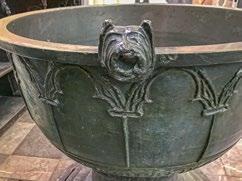
Examples of sculptures decorating the armrests of the stalls (15 th century) at the back wall of the Chapel










Altar of the Dormition of the Blessed Virgin Mary and its fragment (1620–1630)


94
The other witness to Nicolaus Copernicus’ youth, but elusive and not material is the majestic voice of Tuba Dei whose sound has been heard in Toruń since 1500. The poem composed by the bell ringer
Krzysztof Przegiętka, with the message representing the wish that flows with the music of Tuba Dei, is addressed not only to all residents of Toruń but also to all guests who feel the atmosphere of

Krzysztof Przegiętka
Tuba Dei
authentic Gothic while visiting Copernicus’ Town. This poem certainly takes on special meaning as we celebrate the 550 th birthday of the Giant of Science, especially when realizing that Copernicus also heard the same music of Tuba Dei as he was born in a house close to the St. John’s the Baptist and St. John’s the Apostle Church (now Cathedral).
Oto wołam
Mój głos biegnie ponad miastem
Przez dalekie przedmieścia przenika niby przez czas Ściga się z ptakami i dyktuje zegarom godzinę
Oto śpiewam
Pieśń moja niesie się srebrzystym korytem rzeki
Do miejsc przesiąkniętych zapachem wiślanego piachu i wiatrem
Tam gaśnie spełniona
Oto gram
Dźwięki mojej muzyki rozbrzmiewają w ciszy poranka
Opadają na dachy kamienic i podskakują po wypukłym bruku
By na powrót wzbić się modlitwą ku górze
Oto wzywam cię
Mój krzyk przedziera się przez gwar ulicy Słyszysz? Wzywam ciebie – Żyj, kochaj, módl się i pracuj!
Jak ja, od 500 lat
Tuba Dei
Here I am calling
My voice runs above the city
Through distant suburbs it penetrates like through time
It races the birds and dictates time to clocks
Here I am singing
My song is carried by the silver riverbed
To the places full of smell of Wisła’s sand and wind
And there it goes out fulfilled
Here I am ringing
The tunes of my music linger in the silence of the morning
They fall on the roofs of houses and bounce on uneven pavement
Only to fly back up as a prayer
Here I am calling you
My scream breaks through the hum of the street
Can you hear? I am calling you – live, love, pray and work!
As I have been doing, for 500 years
Lidia Smentek March 2022


95


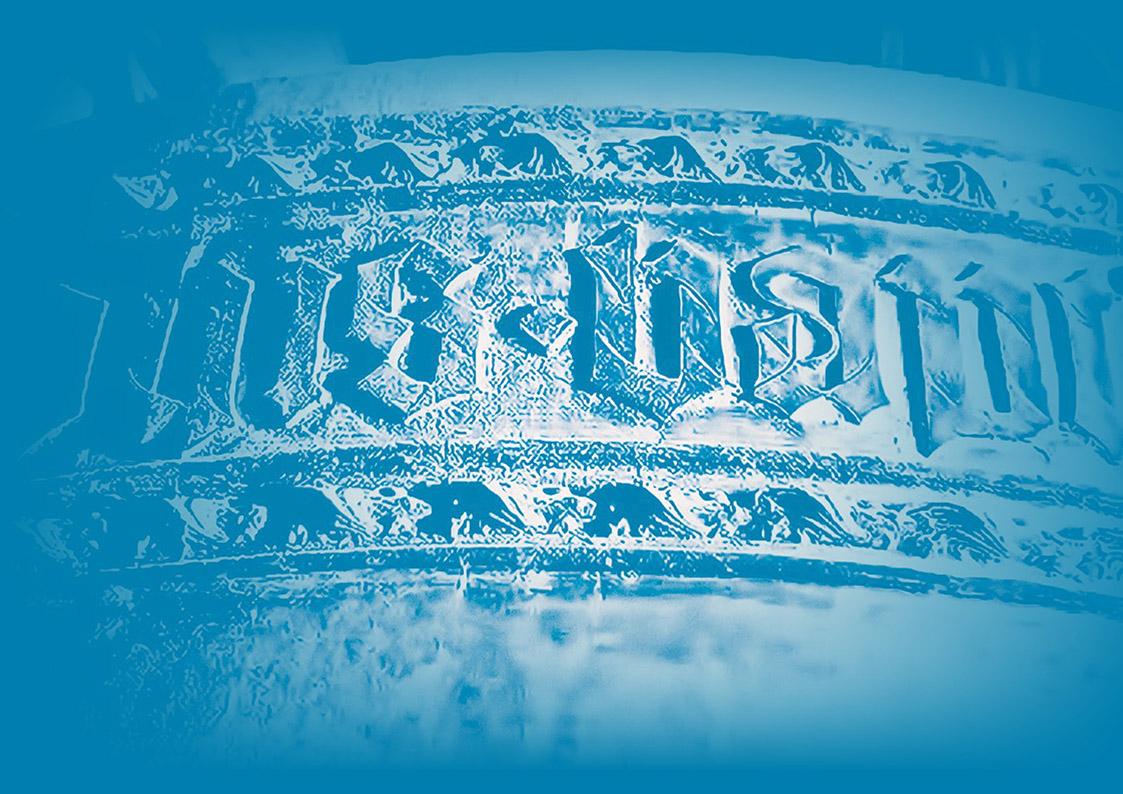


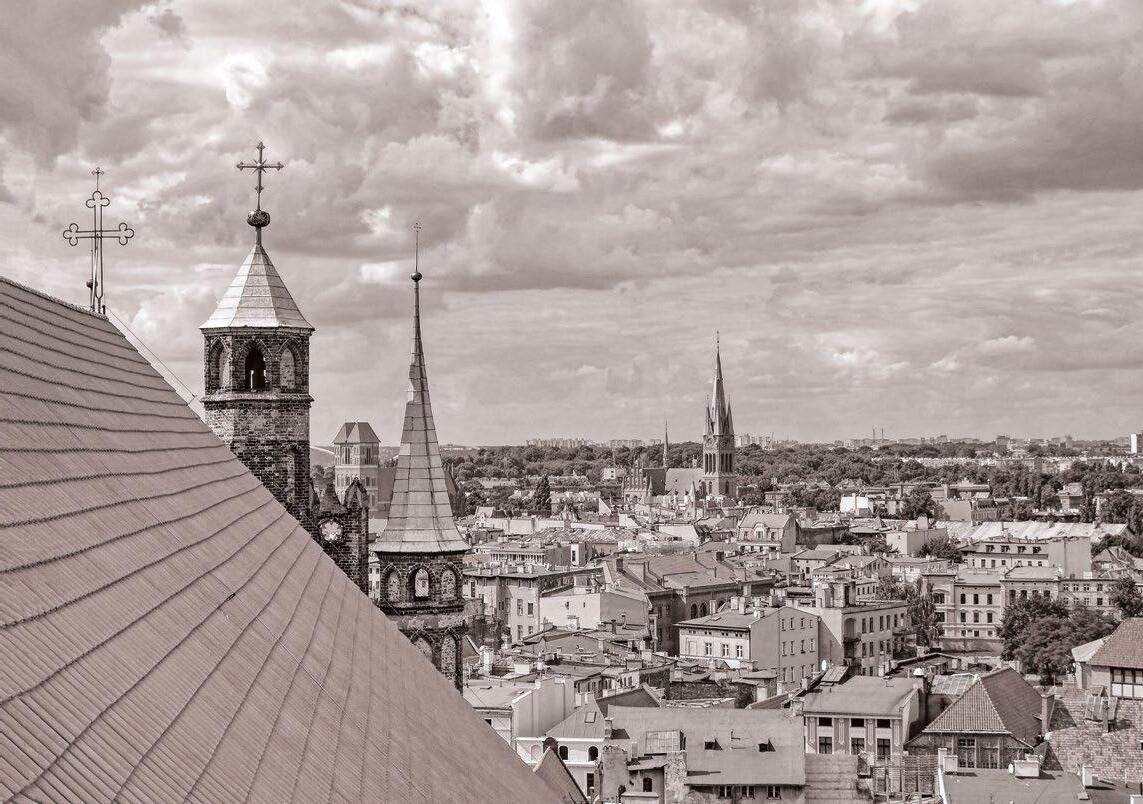

 Lidia Smentek
Lidia Smentek




































































 Stary Rynek 1
Stary Rynek 1
















 New Town Market
New Town Market




 In a distance the Sewage Tower of the Teutonic Knights’ castle (13 th century)
In a distance the Sewage Tower of the Teutonic Knights’ castle (13 th century)




















 Manor
Manor
















































 Dominican Square and outline of the foundation of the St. Nicolas’ Church built in 1334 and demolished in the first half of 19 th century
Dominican Square and outline of the foundation of the St. Nicolas’ Church built in 1334 and demolished in the first half of 19 th century

















































 A sharp arch of a window opening typical of the Gothic style, filled with a brick tracery with a geometric pattern used as frames for the stained glass windows
Four-leaf tracery made of profiled bricks as a decorative frieze
A sharp arch of a window opening typical of the Gothic style, filled with a brick tracery with a geometric pattern used as frames for the stained glass windows
Four-leaf tracery made of profiled bricks as a decorative frieze




























